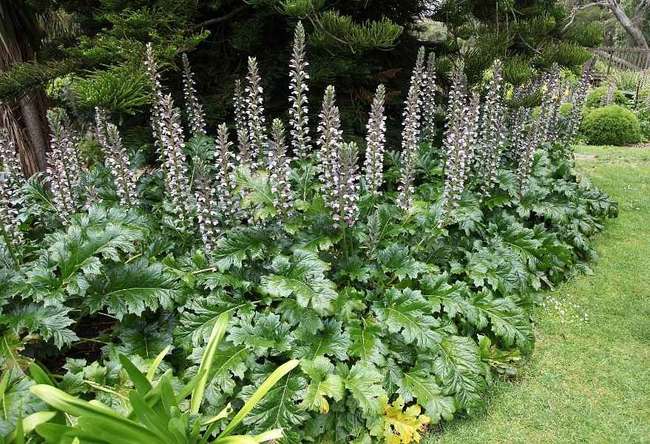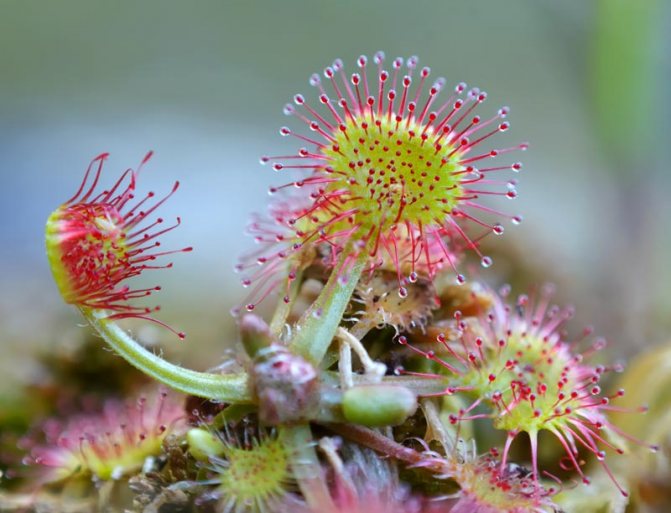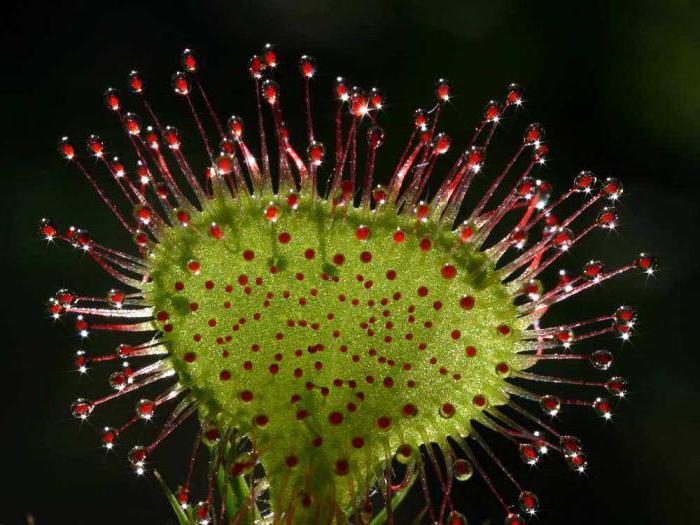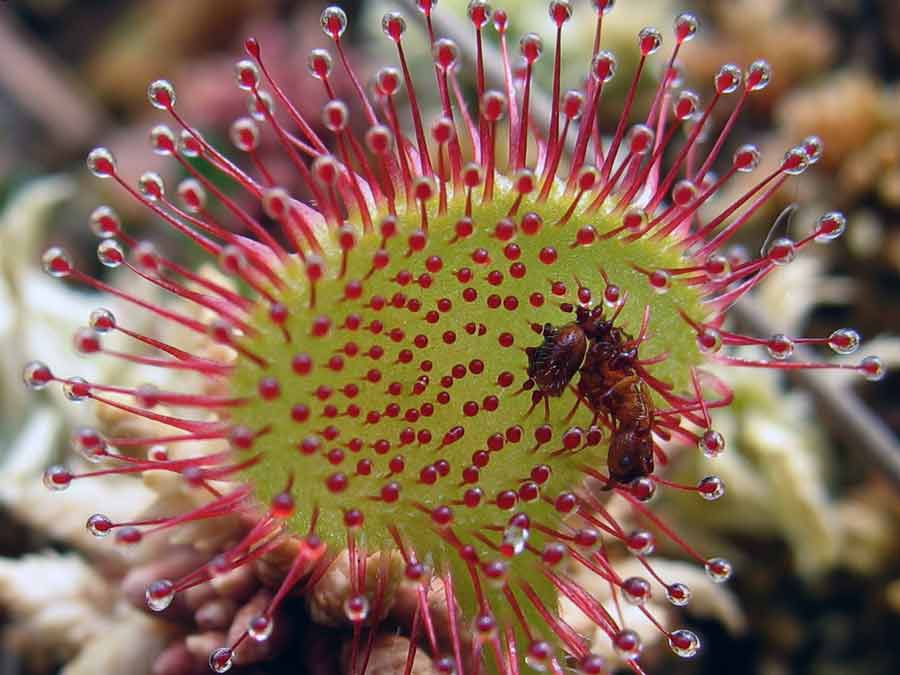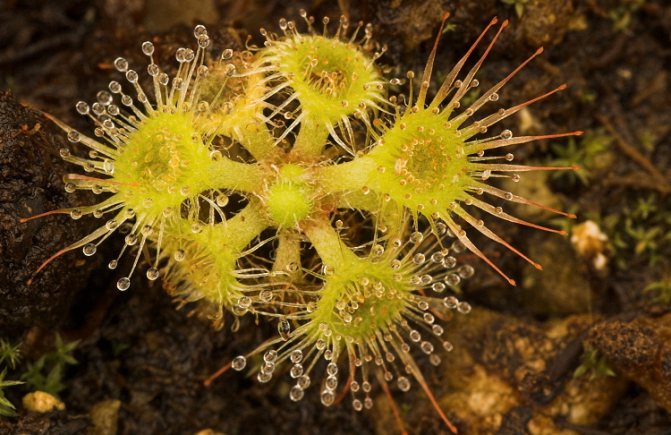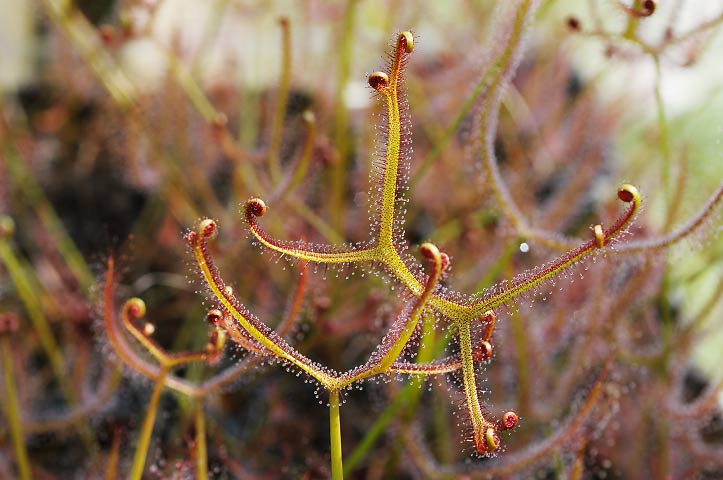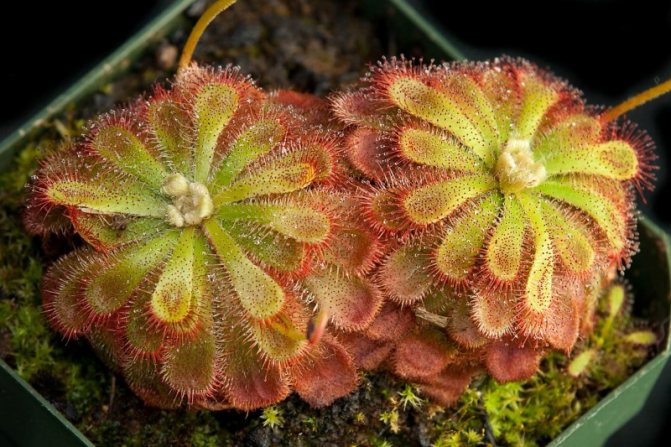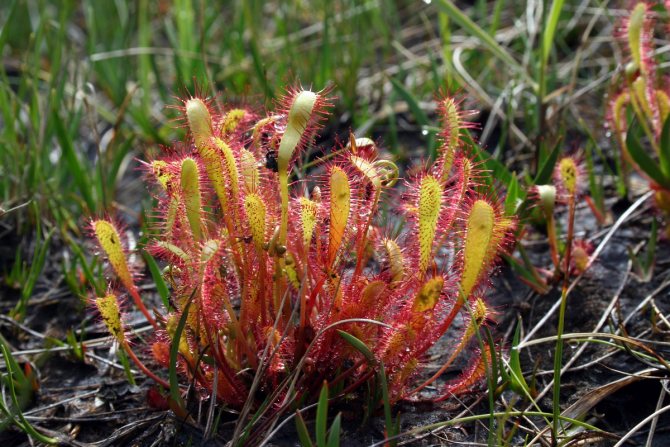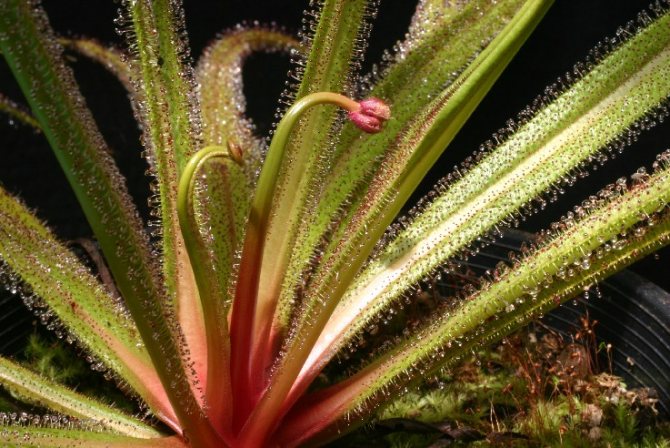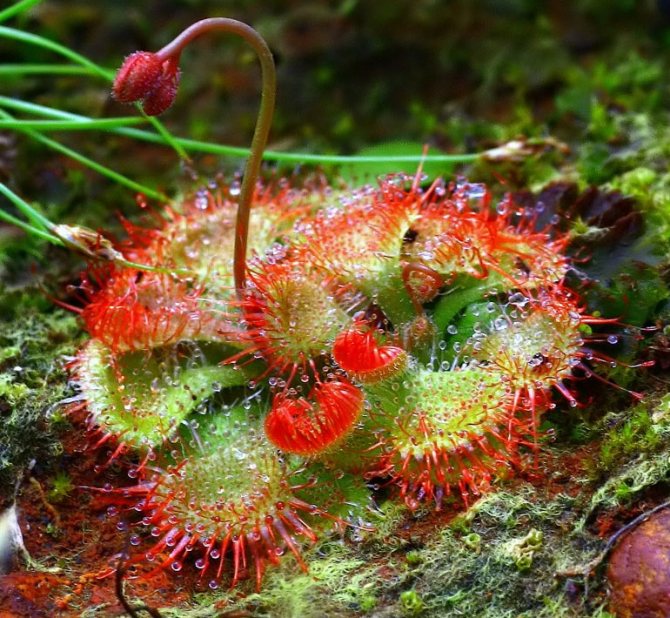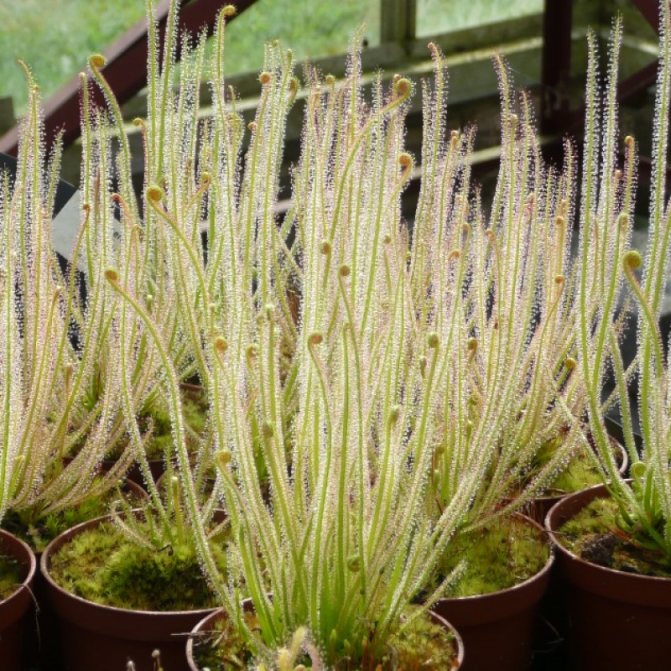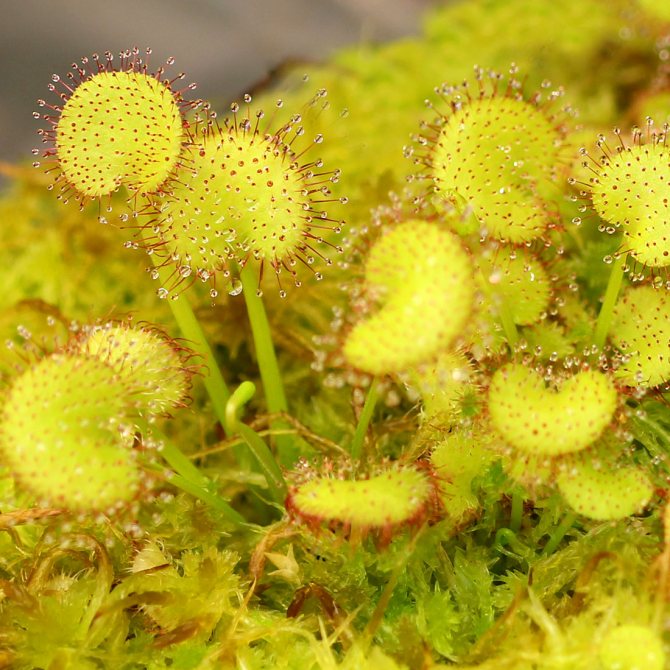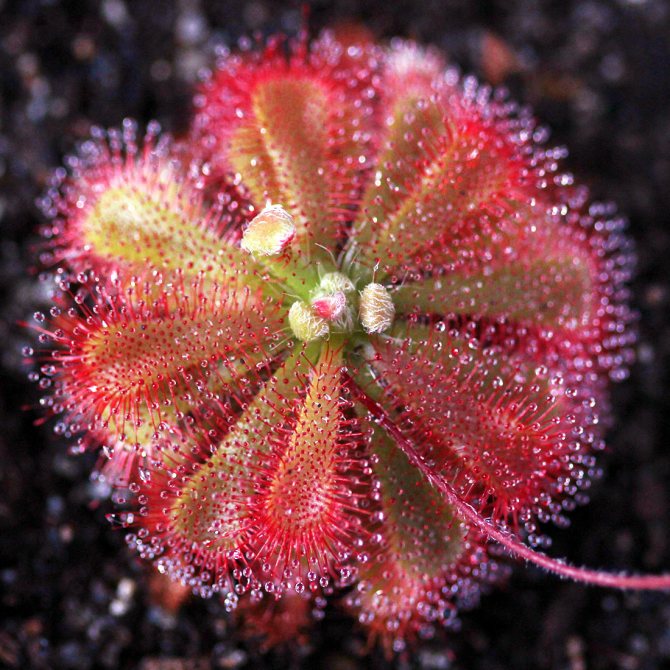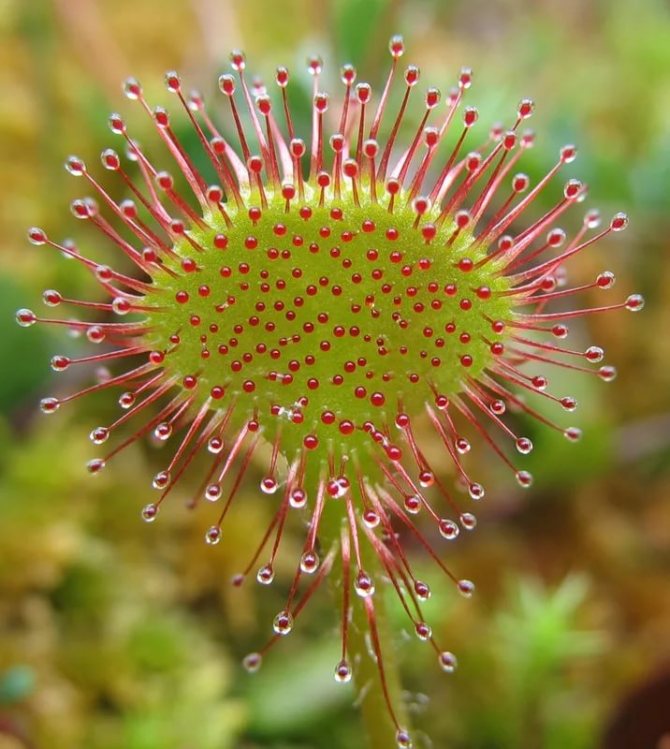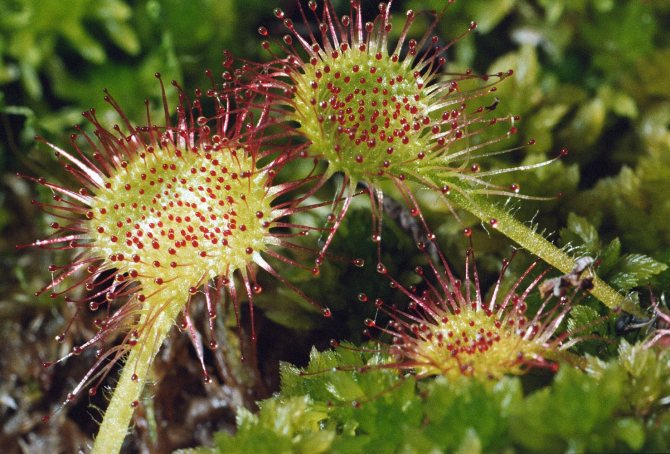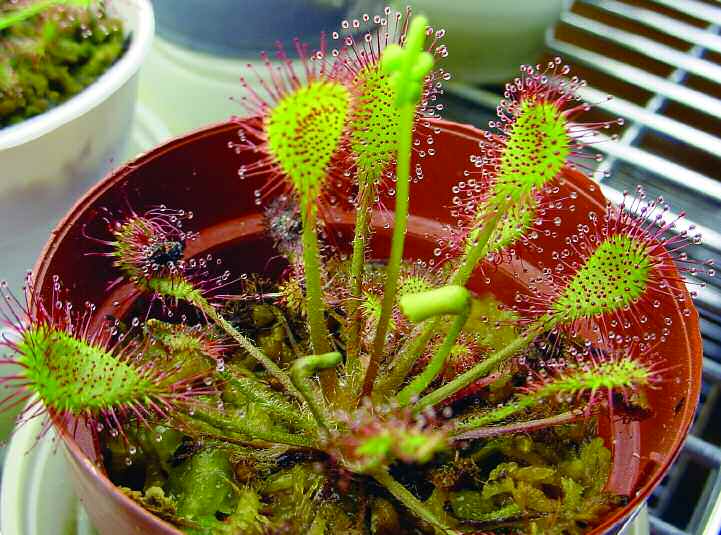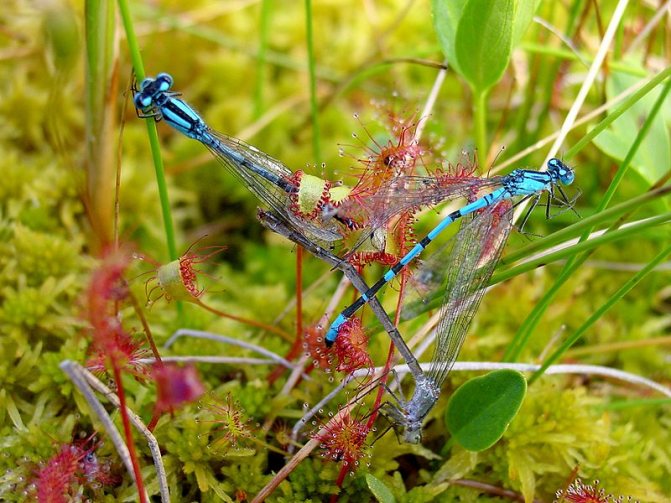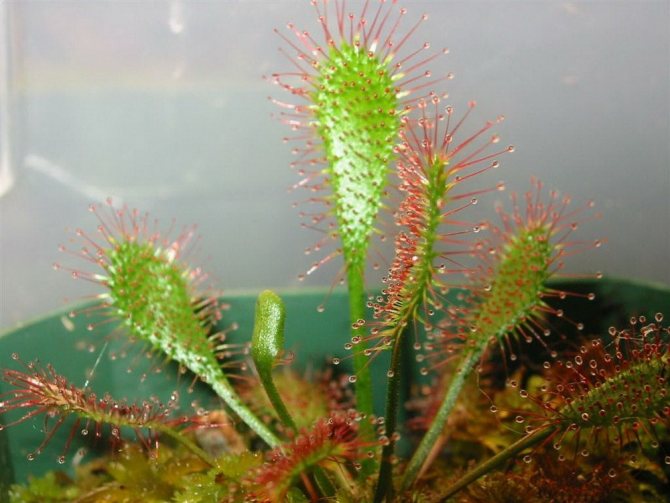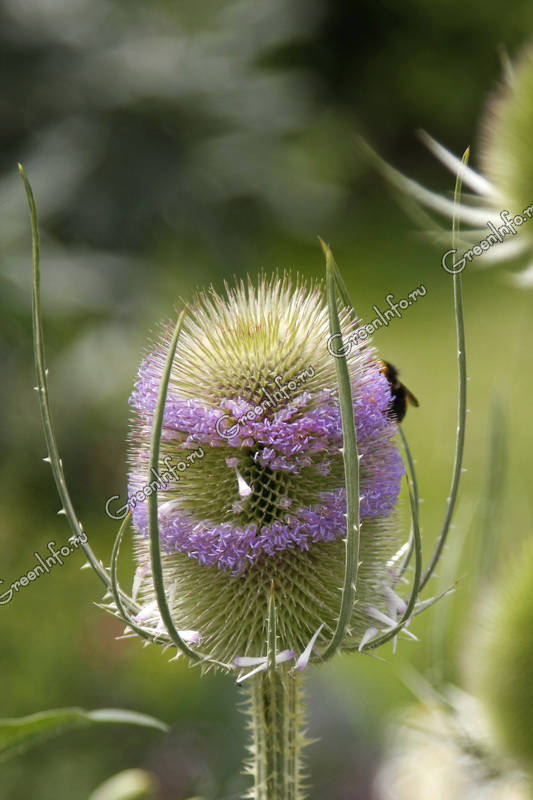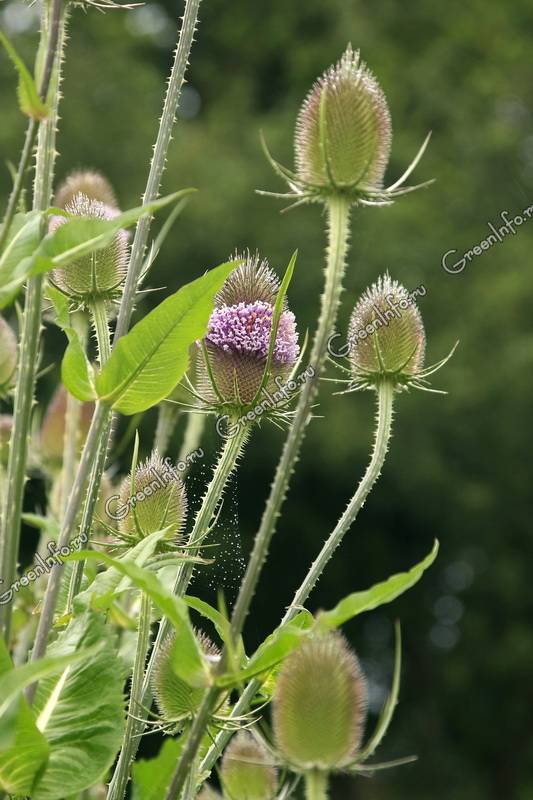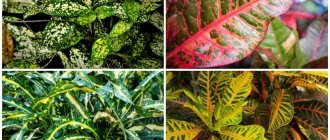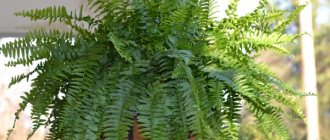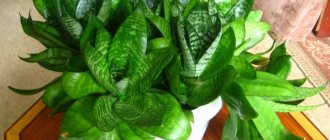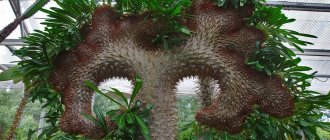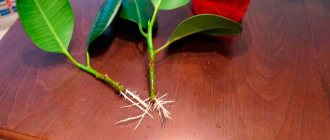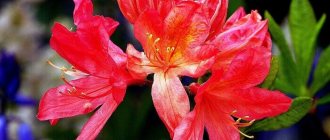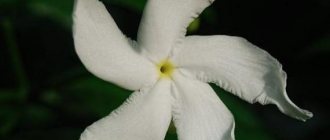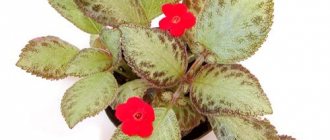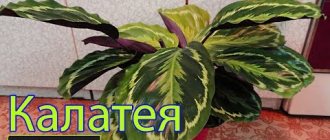Rosyanka (Drosera) is a carnivorous plant that belongs to the Rosyanka family. The habitat is the zones of Japan, China, Taiwan, Australia and New Zealand, where the subtropical and tropical climate reigns. Some of the 150 species grow wild in European swamps. In Russia, only four species of the genus Rosyanka are grown: round-leaved sundew (Drosera rotundifolia), English sundew (Drosera anglica), intermediate sundew (Drosera intermedia), obovate sundew (Drosera obovata). The name of the perennial comes from the Greek words: drosos - dew or droseros - wet with dew. Rosyanka is an autotrophic and heterotrophic plant, thus representing an interesting object for observation, a useful plant for growing at home.
General information
The culture has a thin or thickened herbaceous stem with leaf blades collected in a basal rosette. On the surface and edges of the leaves, glandular hairs are located, which secrete a sticky substance similar to dew. It is thanks to this feature that the plant was called the sundew.
In botany, more than a hundred varieties of this plant predator are known, but at home you can only grow Cape sundew. It is found in home collections of florists, due to its unpretentiousness, ease of care and exotic appearance.

Insect feeding mechanism
Dewdrop attracts, captures, digests its victims with glands. The plant is distinguished by small, oval leaves that create a grounded basal rosette, to which tentacles are attached. On the leaves there are nodules that strongly emit a viscous liquid with a honey smell. Drops of liquid, shining in the sun, attract insects with their smell, insects that land on leaves immediately adhere. When the insect stuck, the flower captures the victim with sticky tentacles, after digestion, the tentacles return to their original position.
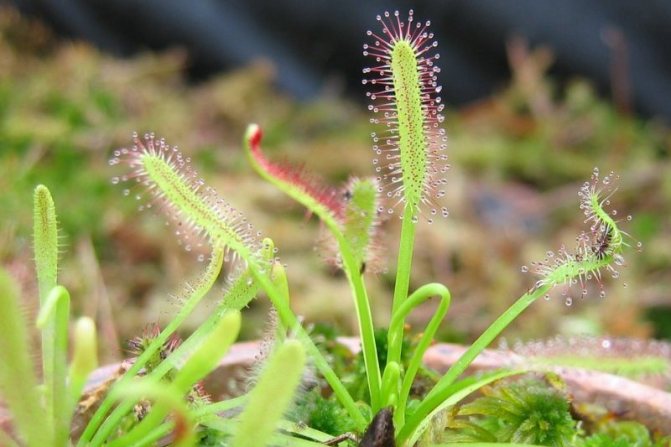

Types and varieties of sundew
Rosyanka Round-leaved - the plant reaches a height of 10 to 15 centimeters. It has light green leaf blades of a rounded shape with reddish tentacles. The peduncle of the culture grows up to 20 centimeters. Flowering time is in the middle of summer. Inflorescences are small, white or pink.
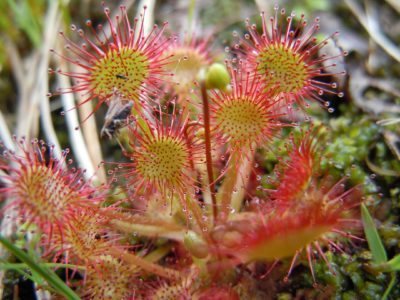

Rosyanka Kapskaya - this kind of culture is the most beautiful and popular. The plant reaches a height of up to 12 centimeters. The sundew has fine, small white hairs, with the help of which it catches prey. The culture blooms in the middle of summer. The inflorescences are spike-shaped. On them are small white flowers with a light, pleasant aroma.


Dewdrop English - the plant grows up to 15 centimeters, and the height of the peduncle reaches 25 centimeters. The leaf plates of the culture are long, directed upwards, lanceolate. Flowering time is in the middle of summer. The inflorescence is spicate with small, white flowers. The plant has medicinal properties and is used in herbal medicine.


Rosyanka Alicia - in the wild, the plant grows in South Africa. The culture has elongated, sessile, multi-tiered leaf plates growing from a rounded rosette. Leaves are yellow-green with red villi.Inflorescences are small, pink.
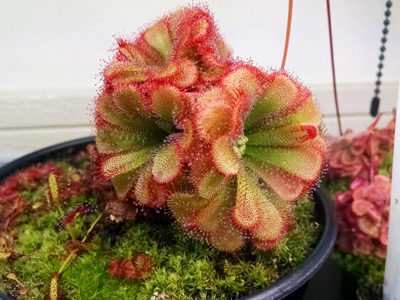

Rosyanka Spatulata
Translated into Russian, this type of sundew sounds like a "spoon". This name was given to her due to the shape of bright green leaf plates with reddish hairs in the shape of a spoon. The height of the culture reaches from 10 to 15 centimeters. The diameter of an adult sundew is 6 centimeters. In the wild, it grows in Africa, Zealand and Australia.
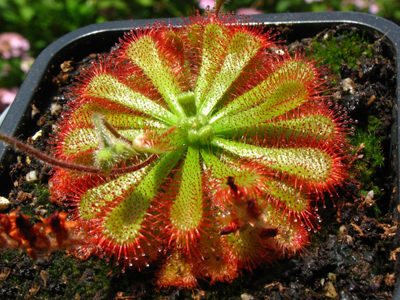

Rosyanka Intermediate - represents one of the most unpretentious varieties of sundew. The leaf plates are lanceolate and light green in color with numerous red villi. They are small and slightly curved. The height of the plant is no more than 8 centimeters. The culture blooms in summer, with white inflorescences.
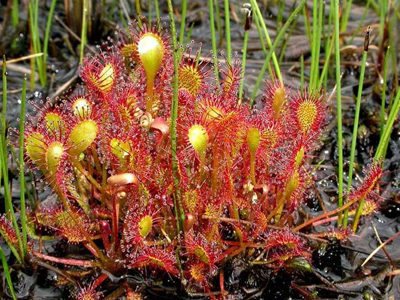

Rosyanka Swamp - in nature, the plant grows mainly in swampy areas, as it loves moisture and swampy soil very much. The height of the culture reaches 15 centimeters, and the peduncle grows up to 20 centimeters. The leaf plates are long, lanceolate, yellow-green with red villi. Sundew blossom time is in the middle of summer. The inflorescence is spike-shaped with small, white flowers.
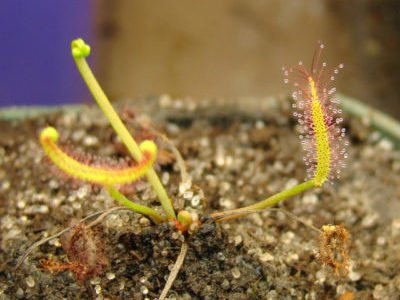

Rosyanka Ordinary - the Far East is considered the birthplace of the plant. This variety is notable for its short stature, although some specimens of the sundew grow up to 25 centimeters in length. The leaf plates are rounded, grow from a root rosette and have an olive tint with red villi. The culture blooms in summer, with small white flowers.
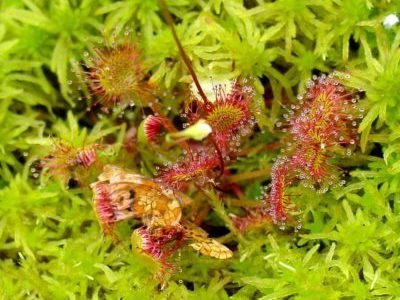

Dewdrop long-leaved
Plant height ranges from 10 to 20 centimeters. The leaf plates are rounded, bright green with long, reddish villi. The culture blooms from June to July with white, spike-shaped inflorescences.
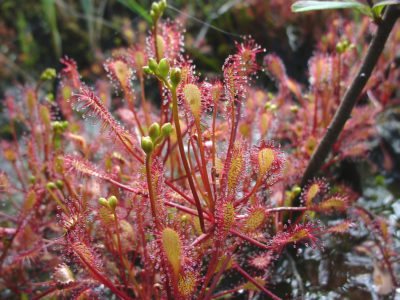

Rosyanka Nidiformis - is endemic to South Africa. This type of sundew is undersized, reaching a diameter of up to 8 centimeters. The plant is 10 centimeters tall. It has narrow leaves with an extended, rounded edge. Red villi cover only the upper part of the leaf and in the sun give the culture a ruby hue. Sundew blossom time is in the middle of summer.


Rosyanka Alba - one of the most unpretentious and exotic species. The culture reaches a height of up to 20 centimeters. It has a short stem with a bundle of thin, linear leaf plates with a thin petiole. The color of the leaves is light green with green villi. When the plant catches an insect, the leaves roll up.
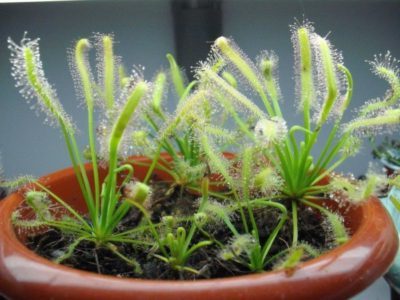

Dewdrop Threadlike - the largest representative of its subspecies, reaching a height of 50 centimeters. The culture has linear, erect, shimmering light green leaves with white villi. Culture grows in the USA and Canada. The flowering time of the plant is in the middle of summer. Flowers are small, white.
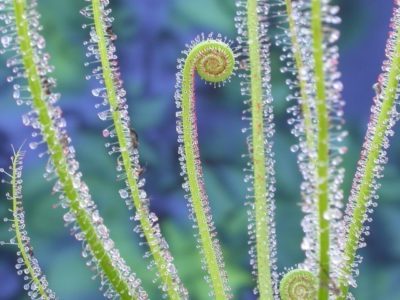

Description
Dewdrop, a perennial plant, sometimes an annual. The leaves are spatulate, green-red, covered with hairs with sticky mucus. The leaves act as a trap for insects, the sticky secretions contain etching substances. Pink with a white tint, sometimes purple, flowers adorn the plant, have a radial and bowl-shaped shape, the diameter is 2 cm. Flowering occurs from May to August. The fruit of the plant is a capsule.
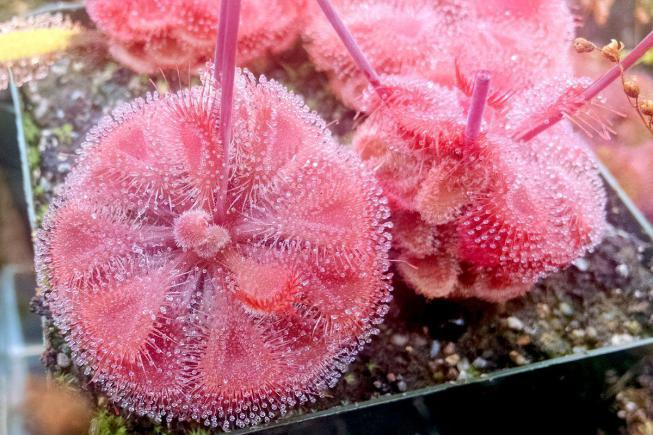

Dewdrop home care
In order for this exotic and carnivorous culture to feel good as a potted plant, the florist must create a microclimate for it in which it grows in the wild.
For a sundew, you need to select a place that will be well lit and constantly ventilated. It is best to place the crop pot next to the south window.You cannot place a sundew on the window, otherwise, under the influence of direct sunlight, burns will remain on it, which will lead to the leaf plates falling off.
In the shade, the plant will also feel bad and may die over time. The most optimal option for growing it will be a place where direct sunlight falls only in the evening.
In order to create additional illumination, you can use a phytolamp, but you do not need to turn it to the light source, the lamp should be a little further away. If a grower uses artificial lighting, he must adhere to the same safety measures as with the sun.
Temperature regime
Since the sundew is endemic to the tropics, the temperature regime for its normal growth should not drop below 18 degrees. This rule also applies for the winter period.
Those crops that grow in the northern regions can grow at temperatures from 5 degrees Celsius. When growing a plant in a pot, it needs to create a temperature of 13 to 20 degrees. In winter, the temperature should be between 7 and 10 degrees. For each of the plant varieties, the temperature will be different, therefore, when purchasing it, you should ask the seller about it.
Air humidity
The air humidity required by the plant should not be less than 60%. Dewdrop is very fond of high humidity as it grows in the tropics or wetlands. To provide her with the necessary microclimate, you need to put a tray with water or a humidifier next to her. You can also place the flower in a shallow aquarium sent with moist moss, which will need to be moistened as it dries.
If a florist decides to grow a sundew in an aquarium, then the plant must necessarily protrude beyond its edges. It should not be placed next to glass, as the refracted rays of the sun will cause severe burns on the leaves. And one more point that should be taken into account is that the sundew cannot be sprayed.
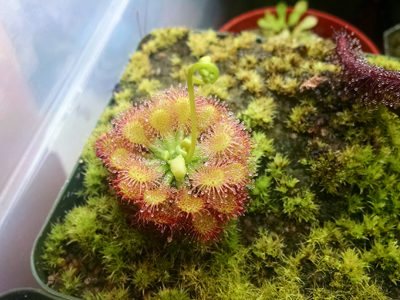

Procurement of raw materials
The optimal time for harvesting round-leaved sundew grass is the beginning of flowering:
- Gently lift the flower out of the soil or cut the stem directly at the surface of the soil.
- Thoroughly remove moss and dirt from the plant.
- Dry the sundew at a temperature not exceeding 40 ° C.
The Resource Council recommends not drying the plant for too long, as this will significantly reduce the useful properties of the raw material. Try it. speed up the procedure as much as possible. The optimal conditions will be a low temperature in combination with good ventilation of the room.
Dry herb should be used within 2 years.
Watering the sundew
The plant needs the soil to be moist all the time, but waterlogging should not be allowed. Watering should be abundant. Water should be used warm and settled. It is necessary to bring moisture under the plant once a week, the rest of the time to spray the top layer of earth from a spray bottle. It is best to water the plant in a tray.
You cannot spray it, as its decorative effect will disappear. In order to increase the humidity of the air in the summer, it can be sprayed around the plant with a spray bottle, making sure that no drops fall on the foliage. You can also put wet sphagnum on the pallet. The water in the culture pan can only be left in the summer.
It should also be noted that the root system should not come into contact with water, therefore, when planting, the plant should provide good drainage from perlite, which is part of the soil. Tap water cannot be used for watering, as it contains a lot of salts. Rain, distilled, filtered, or settled water at room temperature will do. During the winter season, it can be slightly warm.
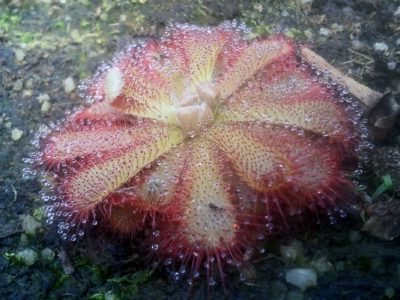

1. Seven Secrets of Success:
| 1. Growing temperature: you can keep the sundew all year round at room temperature between 16 and 24 ° C.Some varieties of sundew require a cool rest period at temperatures between 7 and 12 degrees Celsius. |
| 2. Lighting: daily sunbathing in the morning and evening hours for 4 - 5 hours. During the day, plants should be protected from direct sunlight. |
| 3. Watering and humidity: regular watering - the substrate should be kept evenly moist throughout the year. Better to use bottom irrigation. so as not to wash off the dew drops on the leaves with water. The air humidity is high, without the use of spraying. |
| 4. Features of the: Plants are often severely affected by the lack of a cool dormant period during the winter months. |
| 5. Priming: very acidic, nutrient-poor substrate with good drainage. |
| 6. Top dressing: no feeding is carried out. The sundew can catch insects necessary for life on the balcony or loggia itself. |
| 7. Reproduction: sowing seeds in spring and small daughter rosettes, dividing adult plants during spring transplantation. |
Botanical name: Drosera.
Sundew plant - family... Rosyankovye.
Where grows... North America, North Europe and North Asia. In nature, these plants live in swamps.


Description... Sundews - perennial insectivorous plants - predators with thin, leafless peduncles, and white, crimson or pink flowers... Each flower only stays open for 1 day and consists of several thin, oblong petals.
Flowers are pollinated by insects, so the peduncles of predatory plants are very tall - so that insects - pollinators do not accidentally fall on the leaves - traps.
After pollination, the plants form fruit - seed pods with a lot of small seeds.
Leaves long and narrow, reminiscent of a spoon, up to 8 cm long, form with spoon-shaped rosettes, green, covered with sensitive, red hairs.
Each hair is supplied droplet of sticky liquidthat attracts insects.
As soon as the insect touches the bristles, the leaf curls up and prevents the victim from slipping out of the trap. The droplets of moisture on the leaves contain a wide variety of acids and digestive enzymes that can dissolve even cartilage and small bones.
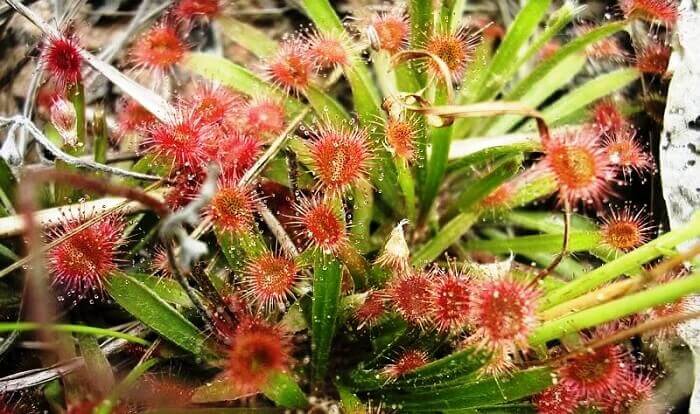

Sundew soil
This predatory culture needs a special substrate. The florist must take this fact into account when transplanting it. As mentioned above, in the wild, sundew grows in swampy areas and subtropics, which means that for normal growth and development, it must be provided with suitable soil.
The soil should be acidic, light and depleted. The best option for her would be peat mixed with sand or quartz chips. To prepare this mixture for the earth, you need to take three parts of peat, two parts of sand, or part of perlite.
The sand should be quartz, as it does not contain salts that are dangerous for sundew. However, if the grower cannot find such sand, he can replace it with perlite.
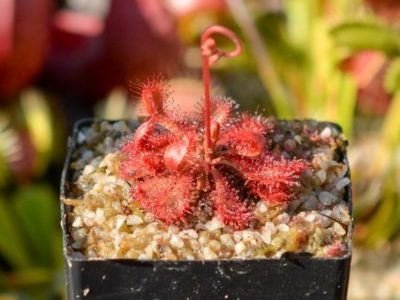

Round-leaved sundew: where does it grow?


The round-leaved sundew is a common plant in the Northern Hemisphere. In Russia, it can be found throughout the entire European part, with the exception of the south and southeast, where it is too warm, as well as Siberia and the Far East. The plant is common for the non-chernozem belt. It is capable of forming large populations with a large number of individuals and a large coverage area.
There are regions where the round-leaved sundew is rather poorly represented. The Red Data Book of the Moscow, Tula, Lipetsk and Kaluga Regions classifies this species into the second category, that is, considers it vulnerable, decreasing in number. The limiting factor is the destruction of natural habitats: eutrophication and drainage of bogs, their overgrowth with forests and shrubs, fires of grass and peat etiology, industrial extraction of peat.
Sundew pot
Since the plant has a weak superficial root system, it is not necessary to choose a large and deep container for planting. It is enough to purchase a shallow pot with a diameter of 10 centimeters.
There must be drainage holes at the bottom. The plant does not need drainage, its role will be performed by perlite, which is part of the soil.
Expanded clay cannot be placed on the bottom of the pot, since it will give an alkaline reaction, and it also contains many salts that are dangerous to the plant.
The pot should be chosen in a light shade so that the soil does not overheat in the sun, especially in the summer.
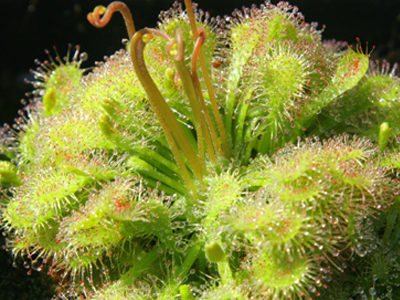

Wintering period
In the cold season, the plant appears wintering buds... As they grow, they go deeper into the forest moss. If you come to a swampy area where a sundew grows after frost, it will be impossible to see this plant. Dewdrop will completely hidden under forest moss.
Thanks to this way of growth, the moss protects the flower from frost, and the sundew successfully survives the cold.
In the spring, when the temperature becomes stable and the first sun appears, the first shoots grow from the wintering buds of this representative of the flora.
Sundew transplant
The sundew should be transplanted in early spring, when it comes out of the dormant period. The substrate is prepared from peat, sphagnum and perlite in equal parts. All components of the earth of the mixture must be mixed in such a way that it turns out to be light and loose.
When carrying out a transplant, the soil cannot be greatly softened. The acidity of the soil should be around 4 pH. The pot should be taken not deep and always with drainage holes at the bottom of the container. The plant must be pulled out of the pot and shaken off the old soil from the roots. Damaged and rotten roots must be removed.
The transplant is carried out annually, since the mixture is caked on the ground and oxygen does not come to the root system, as a result of which, the roots begin to die off. If you do not adhere to these rules and do not transplant the sundew, it will die. With good care, the sundew will delight its owner for more than half a century.
After transplantation, the culture may lose dew on the villi - this is quite normal. To make it easier for the plant to adapt after transplanting, the pot must be covered with a film to maintain moisture. After a week, dew will reappear on the leaves.
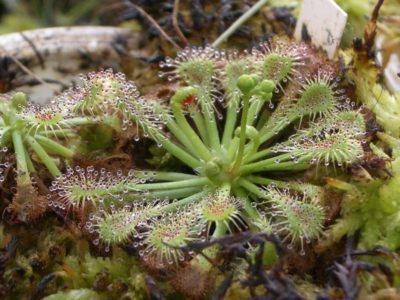

How is insect catching?
As mentioned above, the surface of the leaf and its margins are covered with numerous glandular hairs. They have the shape of heads located on long stems 4-5 mm high. The round-leaved sundew is characterized by an active mechanism for catching its prey. Hair constantly secretes a special sticky liquid that forms small shiny droplets. They are sensitive to external stimuli. When an insect, attracted by the liquid (or accidentally), touches the hairs, they begin to move, bend, deftly capturing it in their nets.
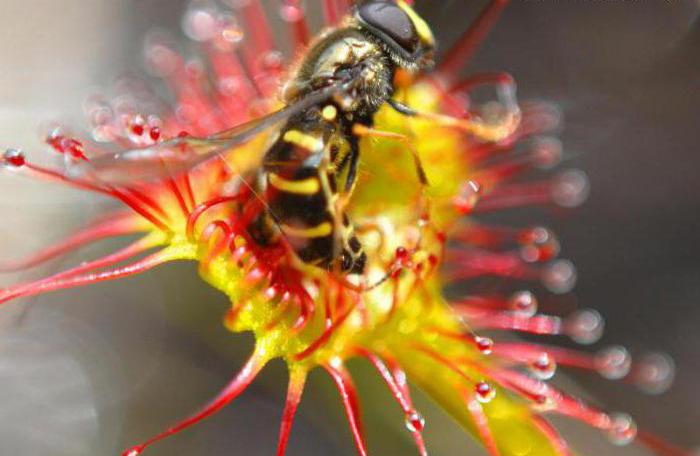

Fertilizers for sundew
The sunflower does not need any soil dressing, since its root system cannot receive the substances necessary for growth and development from the soil. For this reason, the grower must ensure that the crop receives the necessary nutrition from catching insects.
She should "eat" about two or three flies a week - that will be enough for her. If there are no insects in the apartment, then the plant must be taken out into the street for hunting, or you must bring prey to it yourself.
Insects should not be large, as they will damage the leaf plates. It is forbidden to give meat and fish to the culture; only flies, bugs or mosquitoes are suitable for it, which in extreme cases can be bought at a pet store.
Nepentes is also a carnivorous plant from the Nepente family. It is grown when nursing at home without much difficulty, if you follow the plant's agricultural technology. All the necessary recommendations for the cultivation and care of this plant can be found in this article.


Contraindications
As with any drug, a doctor's consultation is required before starting to use sundew-based drugs. An overdose of tea, infusion or decoction of this plant is fraught with nausea and vomiting. Excessive consumption of sundew tincture will lead to serious poisoning.


You can not use preparations based on sundew under the following conditions:
- pregnancy;
- lactation;
- epilepsy.
Sundew blossom
Dewdrop blooms in mid-summer, white, small flowers. When the plant blooms, the grower needs to think about pollination in order to get crop seeds in the future.
Pollination can be carried out both artificially, by transferring pollen from flower to flower, and naturally, by taking the sundew out into the open air and allowing the bees to pollinate the inflorescences themselves. This procedure should be carried out for about a week.
If pollination is successful, fruit set will occur. A seed pod will appear, which, after ripening, can be opened, and the seeds inside can be used to propagate the sundew.
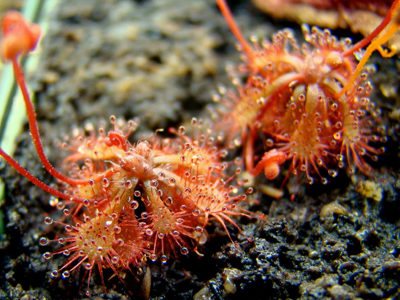

Description of the plant
Dewdrop is a predatory plant that grows in swamps, in America it was nicknamed "sunny dew". There are more than 500 species of insectivorous plants, they are located in all parts of the world, even in cold Siberia their representatives are found.
Often, the plant prefers a temperate climate, but is able to withstand severe Siberian frosts. The sundew forms a bud, it is frost-resistant and due to this it survives. If desired, it can be stored in an airtight bag or sphagnum moss for 3-5 months.
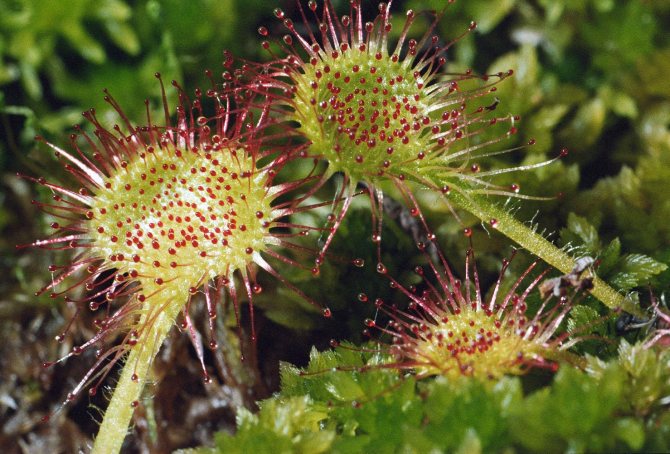

Round-leaved sundew - The flower received this name due to drops of liquid that stand out on the hairs located on its leaves.
The plant is perennial and can easily grow in cold climates.
When in winter the plant has deepened its buds into the moss, in the spring, with the arrival of heat and the first sun, young annual shoots begin to grow from the buds. Shoots are thin, small and located in the thickness of the moss.
Leaves are located on the surface of the moss, on one such plant there are more than 10 leaves. The leaves are small, about 2 cm in diameter. Each leaf of the sundew is covered with a large number of fine red hairs.
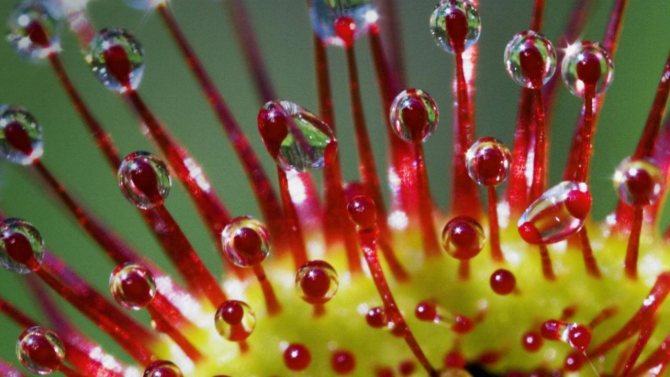

On each such hair, at the very edge, there is a liquid, which is why the plant received such an interesting name. Due to dew, which is located on fine hairs, the carnivorous sundew hunts insects.
Sundew bloom
Some types of sundew give a beautiful color, but not every species can bloom, you may not even know that it is your species that is blooming. Since you can simply miss the growth of the ovaries, and their pollination, from which they may die.


Therefore, as soon as the first ovaries have appeared, the plant must be taken out to the balcony or street. The insects will do everything themselves. Such pollination can be done independently within a week by transferring pollen from one ovary to another, then the fruit will soon be tied, and a box with seeds is formed. The seeds can be collected and used for further propagation.
More on insect feeding
With the appearance of the first warm days, and the midday sun, the sundew rises to the surface. But for such an early appearance, the plant has a rather late flowering. Only in the middle of summer does the flower begin to form flowers.
The plant is pollinated by insects, which risk falling into the dangerous trap of the sundew. Insects are caught in droplets located at the tips of the villi.
Escapes, where the future flower is formed, grow tall - up to 20-26 cm. This happens so that insects that fly in for nectar do not fall for the villi-traps. In the future, a beautiful flower, pale pink or white, is formed on the new shoot.
Lovely 5 petal flowers look fantastic in such a damp and dim terrain of its habitat. Despite the functions of the flower, it looks incredibly delicate and charming. The flower has ripe fruits "nectaries" that help to attract "food" in the form of insects.
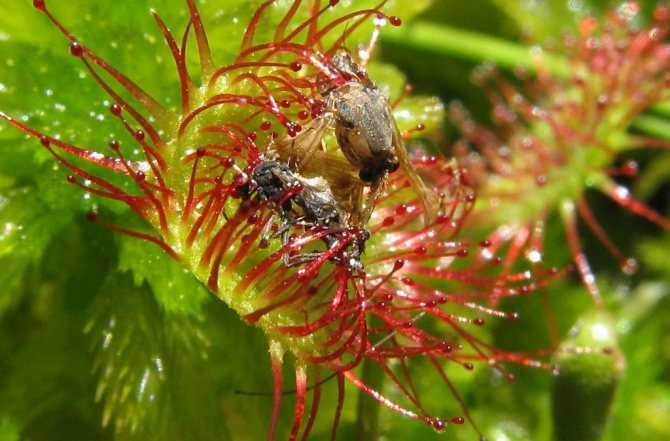

Fruits ripen by the end of summer, they open themselves, revealing the inner seeds. The seeds are scattered to the surface and then lost in the depths of the moss to germinate in the new year.
The peculiarity of the plant is that, thanks to photosynthesis, it itself produces nutritional components for itself.
But even this does not change the fact that the plant is insectivorous. It grows exclusively in swampy areas, there is a significant lack of minerals due to which most plants survive.
Therefore, predators kill flowers in order to make up for the missing components at their expense. If all other flowers bloom on the planets in order to delight the world around and give useful nectar to insects, then the sundew acts on the principle of an egoist, lives only for its own sake, replenishing its own body with missing elements and substances.


Despite its destructive nature, the sundew got its name from the word dew. Its scientific name - "drosera" - comes from the Greek word "drosos", meaning "dew drops".
An excellent name for a plant, which, it should be noted, does indeed have such drops in abundance, which is especially clearly visible in the enlarged photographs presented here.
It would seem who can like this kind of flower. But in fact, there are a lot of lovers of carnivorous plants, they are ready to collect entire collections of such plants, growing them on windows and backyards, admiring their way of life and beauty. But besides this, the plant is recommended in medicine.
Sundew use in alternative medicine
The plant has long been used in alternative medicine. The use of sundew in alternative medicine is much broader than in scientific one. The plant is able to fight diseases: bronchitis, asthma, colds, pneumonia. Medicines based on sundew are prescribed for patients suffering from diseases of the heart vessels, with epilepsy, thrush, treatment of acute respiratory viral infections and acute respiratory infections.
Growing sundew from seeds
For propagation, take fresh seeds, place them in a container on wet sphagnum and cover with a lid. The container is removed to a warm and bright place. For the seeds to germinate faster, the temperature should be 25 degrees.
Freshly harvested seeds sprout in a month, and purchased in a store - within six months. When young plants have four of their own leaf plates, they can be planted in pots.
It should be noted that the first leaf plates of the plant do not have a carnivorous function; they will master this functionality only after four months.
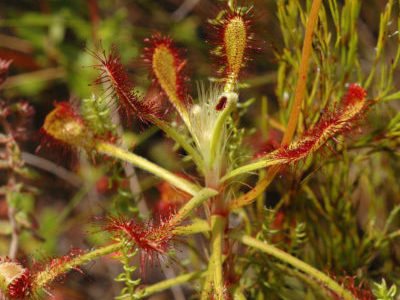

Reproduction
The plant propagates by seed, a difficult process. It is worth leaving seed propagation to specialists with laboratory conditions. You can try to grow seedlings yourself. Sundew seeds are very small, you do not need to sprinkle them with earth, just press them to the base.
Seed germination lasts about 2 weeks at a temperature of 20-25 ° C. Seedlings should be exposed in a sunny place. Saplings are planted when they grow up. After two years, the plant becomes a mature specimen. The sundew also reproduces root cuttings
, cut into pieces 3-5 cm long and laid flat in a container, then covered with a layer of earth.
Sundew propagation by dividing the bush
If a daughter outlet leaves the mother plant, then the sundew can be propagated. The rosette should be carefully separated from the adult culture and planted in a permanent growth site.
If it is large, it can be divided into parts so that each of them has its own roots. The place of separation must be treated with crushed coal, after which each part must be planted in its own container.Young growth will take root very quickly.


About carnivorous plants
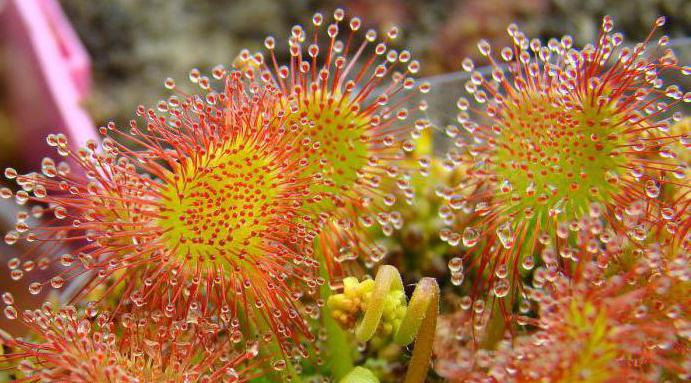

All currently existing carnivorous plants, which are more than 600 species, belong to 19 families, including Rosyankovye. The latter, in particular, includes three genera. Each representative of this group is a perennial herbaceous insectivorous plant, rhizomatous and growing in water or in a swamp. Less common among sundews are dwarf shrubs.
Insectivorous plants became known in the 18th century. An accurate botanical description was first given by the English naturalist D. Ellis in his letter to K. Linnaeus. The object of his observations was the Venus flytrap. It was then that the botanist first made the assumption that insects are food for the plant.
In total, more than a hundred species of the Rosyankovye family are known, and only one representative belongs to the genus Aldrovand and Venus. All the rest belong to the Rosyanka. We will talk about one of them later in the article.
Dewdrop propagation by leaf cuttings
To propagate a sundew with a cuttings, choose a suitable leaf plate and place it in a glass of water, adding a preparation for accelerated root formation to it; you can also root it in the ground with a mixture of sphagnum, peat and sand.
A glass of water or a container of earth with the mixture should be covered with polyethylene. It is necessary to ensure that the cuttings have enough heat, light and moisture. In this case, rooting will be successful.
The most popular propagation method is cuttings and seeds.
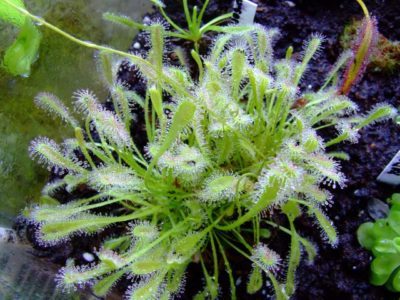

The soil
To create the correct base, peat and fine gravel for aquariums are needed, combined in a 2: 1 ratio. After planting, the surface of the ground is covered with sphagnum moss. Put the prepared pot in a container with water. Humidity around the sundew has a huge effect on the formation of liquid droplets
on sensory hairs. The plant is accustomed to wet conditions, in its natural environment it grows in swamps.


Diseases and pests
If the plant sticky drops on the sheet plates began to dry, then the sundew lacks moisture. To fix this, you need to increase either watering or air humidity. To increase the humidity of the air, you can spray it from time to time from a dispenser or put wet expanded clay next to the pot. You can also place the plant in a damp terrarium and leave it to drink moisture for a while. After such procedures, the problem should disappear.
Yellowing and drying of leaf plates occurs due to root rot that develops when the plant is flooded with water. Watering the sundew should be carried out with exceptionally soft water without salts. To reanimate the sundew, it should be taken out of the pot, shaken off the roots from the ground and removed their decayed parts. Then transplant into a new substrate and pot.
With the disappearance of dew on the leaf plates and the wilting of the plant, the grower must change the soil, which, most likely, does not suit the plant. The sundew should be transplanted into a substrate that is more suitable for it and its condition will return to normal.
Of the pests for culture, only spider mites and aphids, everyone else becomes her prey. If the grower found these insects on the sundew, then the plant should be treated with the Actellik insecticide, gently wiping the lower parts of the leaf plates.
The procedure should be repeated after a few days in order to completely destroy the pests. If the aphid has struck a peduncle, it is better to cut it off, since the sundew needs a lot of energy and vitality to form inflorescences, which it can spend on recovery.


Round-leaved sundew indoors
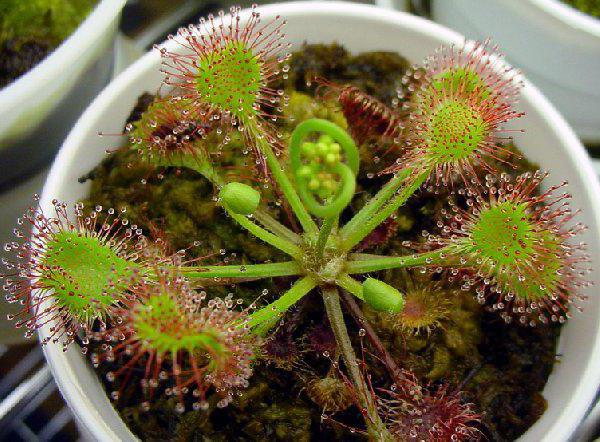

In recent years, sundews and other insectivorous plants have become extremely popular with exotic lovers. Although they are rare and extraordinary, even novice growers can cope with their cultivation with due effort.Note that in the house the sundew will play the role of "orderly", destroying insects, which is also not bad.
Experts recommend paying attention to species that grow in moderately cool climates, they are most suitable for indoor cultivation. The main aspects of caring for the round-leaved sundew are indicated below.
Dewdrop - predator plant
Rosyanka (Drosera) belongs to the herbaceous carnivorous perennials of the Rosyankovye family. There are over 150 species of this carnivorous plant, most of which grow in warm New Zealand, South American, Australian and African climates. Drozera is also found in the more severe, colder northern regions, the only exception is Antarctica.
Sundew and insects
Droseraceae, as the name of the genus of these unusual plants sounds in Latin, literally means "covered with dew". This is exactly what small drops of sticky aromatic secretion look like, located at the ends of the reddish glandular hairs covering the leaf blades. The odor substance they produce attracts insects flying by, which, sitting on a leaf, stick to it tightly and are immobilized by a sticky secret containing paralytic alkaloids.
Then the trap slowly slams shut and the digestive process starts with the participation of organic acids and enzymes. Digestion of food usually takes several days. In such an extremely original way, the flower feeds, receiving the substances it needs for development.
Teasel forest
Teasel forest or felt tease (pink tease, Fuller's tease) is a biennial herbaceous melliferous plant of the Honeysuckle family. It grows along roads, on wastelands, vegetable gardens, glades, meadows, and the banks of water bodies. It is found almost everywhere - in Europe, Asia, America, Africa, Australia. Teasel is used in folk medicine and homeopathy as a plant with a number of medicinal properties.
Teasers are also popular in gardening - they are grown because of the interesting spectacular inflorescences. This plant is also used to produce green paint. Earlier, cloth was made from teasers inflorescences - hence its second name.
Teasel - Wikipedia
From Wikipedia, the free encyclopedia
The current version of the page has not yet been reviewed by experienced contributors and may differ significantly from the version reviewed on September 28, 2017; verification requires 1 edit. The current version of the page has not yet been reviewed by experienced contributors and may differ significantly from the version reviewed on September 28, 2017; verification requires 1 edit.
Teasel
(lat.Dipsácus) is a genus of herbaceous plants of the subfamily Vorsyankovye (
Dipsacoideae
) of the family Honeysuckle (
Caprifoliaceae
).
Teedles are biennial or perennial large herbaceous plants, 1–2.5 m high, with bristly-thorny stems.
Flowers with a saucer-shaped calyx and spiny bracts.
In some species of Teasel, the stem leaves grow together in pairs, forming a cup-shaped container in which water accumulates. This receptacle serves as a trap for insects, which, getting there, soon die, then rot, turning the water accumulated there into a brown viscous liquid that emits an unpleasant odor. This smell scares away the thieves of their nectar from the tease flowers.
Found in tropical and temperate regions of Eurasia, the Mediterranean and tropical Africa.
Teasel sowing, the bracts of which are strong, elastic and elastic scales, pointed and bent downwards in a hook, is cultivated in Russia, European countries and America. Its stems are used for nap fabrics. Since the beginning of the use of metal cards for this purpose in the 20th century, the industrial value of this plant has significantly decreased.
ru.wikipedia.org
Winter maintenance
Scarification is rarely done before growing pine trees from seed, as they have a soft covering, albeit woody. It is based on the destruction of the dense feeding cover of the seed, which prevents its germination. In the natural environment, microorganisms in the soil cope with this task.
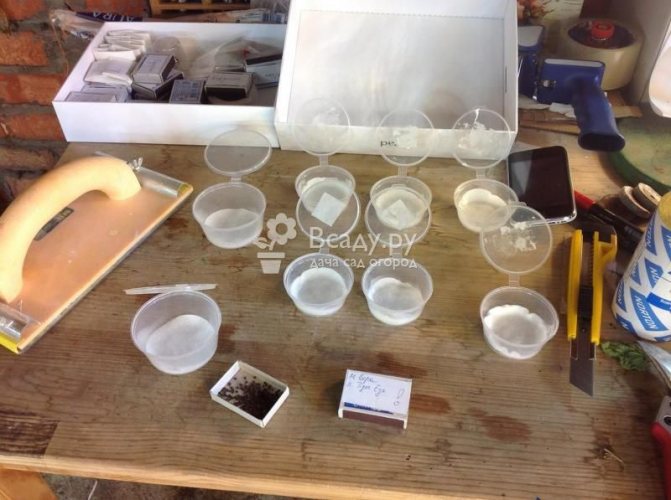

Scarification of ephedra seeds in sulfuric acid
The seeds should be cleaned of feeding wings and debris left after peeling, dried and soaked in sulfuric acid for half an hour. After etching, the material must be rinsed and either sowing or the next stage, stratification, can be started.
There is a less "hard" method for scarification of conifers, but also less effective - it is mechanical stripping of the seed cover. To do this, the material must be shaken out in a container, the walls of which are lined with coarse-grained sandpaper. Since it is impossible to store the seeds of coniferous plants after such manipulations, they are carried out before the sowing itself.
Before growing the seeds of conifers for seedlings, it is imperative to carry out stratification (sprinkling with layers of peat mixture, sawdust or sphagnum moss, followed by processing with high or low temperatures). It is necessary due to the delayed development of the embryo. For germination, they need a lot of time (1-2 years), as well as compliance with the conditions:
- constant high humidity - not less than 80%,
- uniform temperature regime of 21-25 degrees.
For seeds of southern, thermophilic varieties, stratification with heat is suitable, and for northern ones - with cold. For those adapted to the temperate climate of central Russia and ripening by the middle of summer - combined.
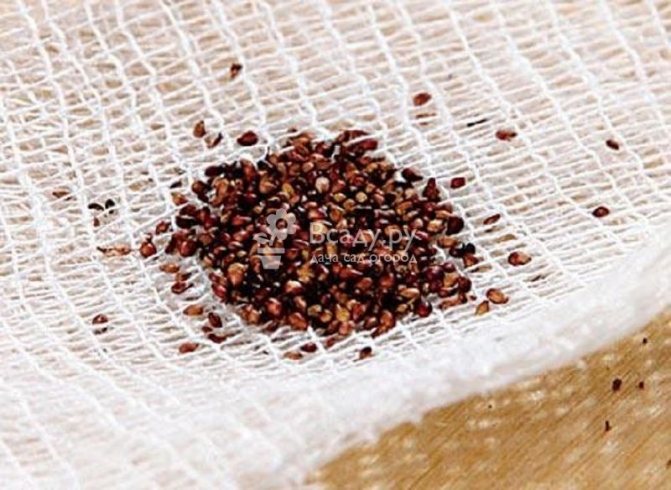

Stratification of conifer seeds for seedlings
The procedure for stratification of conifers at home:
- The initial stage consists in mixing seeds with wet sawdust or peat mixture in a ratio of 1: 3, after which they are placed in closing boxes before germination.
- The seed containers should be removed to a dark room, where the temperature is maintained suitable for the selected type of stratification.
- This process is long, so it is important to periodically inspect the seeds, shake them out, and in case of excessive moisture, replace the substrate in order to avoid decay. Overdrying must not be allowed, which stops the maturation of the material embryos.
- Stratified seeds can be sown in pots or in open ground - the method depends on the type of conifers.
This method is considered to be simpler, but not the most effective. It is used before growing spruce from seeds, as well as for germinating pine, thuja and fir, but mainly for those varieties that do not need long warm or cold periods of embryo ripening.
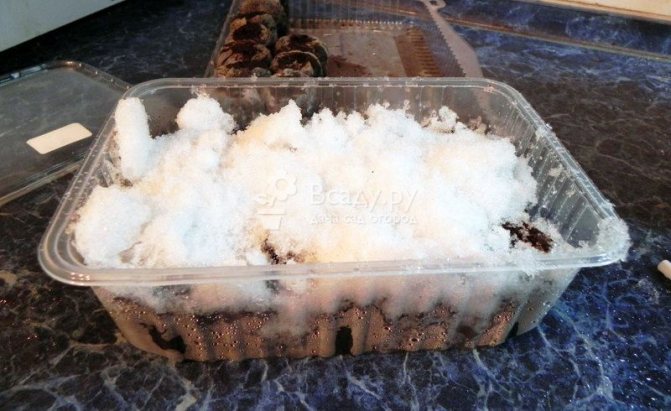

Snowing and growing spruce seeds in peat tablets
For snowing, the seeds are sown in containers that are placed under the snow for the winter. In spring, thermophilic species are transferred to greenhouses for germination, and frost-resistant ones are dug into the ground.
Seedlings of coniferous plants are distinguished by good endurance and unpretentiousness. In order for young trees to develop successfully, they need to provide conditions with moderate light and humidity. They should not be placed on windowsills, but they should not be kept in storage either. Any living space with windows on the sunny side, a heated veranda or a winter garden will do.
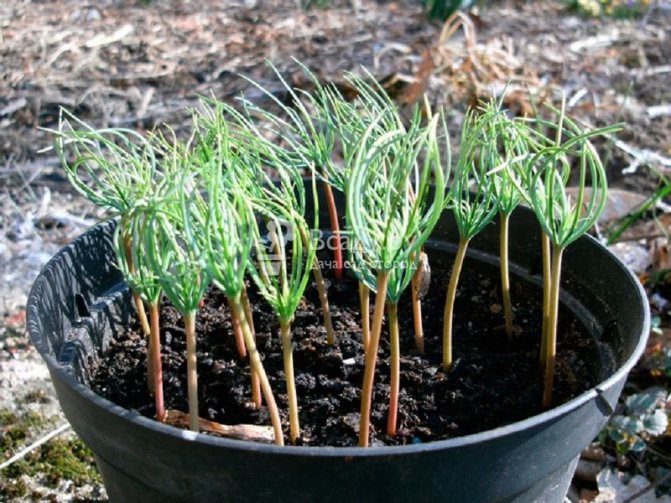

Seedlings of conifers: growing conditions and care
The soil should be loose, and the fertilizers introduced into it should be rotted. They should not contain fresh animal organic matter, which leads to the development of fungi and other microorganisms that can destroy the seedlings.
Conifers can be grown both in open beds and in pots, cassettes, wooden boxes or peat tablets.Each method has disadvantages: in the first case, it is quite difficult to isolate the seedlings from bad climatic conditions and diseases, and in closed ground it is not easy to maintain the correct moisture level.


Seedlings of conifers in the open field
In the first year of life, the root system of the seedlings grows, and after that a period of active growth begins. Grown in special containers or tablets, trees should be planted in the beds at the beginning or closer to the middle of autumn - as soon as the length of their trunk reaches 10-12 cm. Additional feeding is not needed for the conifers.
With the arrival of November, most sundews have a dormant period. It lasts until mid-February. After leaving for the winter, the predator stops hunting and discards the foliage. An inexperienced florist, seeing the state of the "pet" during the rest period, may even think that he is dying.
Sundew care in winter should be special. When the predator is resting, you need to reduce watering to once a week, reduce the air temperature (maximum 12 ° C). The pot should be placed away from heating appliances. During wintering, the humidity in the room should be high.
The Cape sundew has a weakly expressed rest period. Almost the whole year it grows evenly, for which flower growers love it.
| 1. Growing temperature: you can keep the sundew all year round at room temperature in the range of 16 to 24 ° C. Some varieties of sundew need a cool dormant period at a temperature of 7 to 12 degrees Celsius. |
| 2. Lighting: daily sunbathing in the morning and evening hours for 4 - 5 hours. During the day, plants should be protected from direct sunlight. |
| 3. Watering and air humidity: regular watering - the substrate should be kept evenly moist throughout the year. Better to use bottom irrigation. so as not to wash off the dew drops on the leaves with water. The air humidity is high, without the use of spraying. |
| 4. Features: Plants are often severely affected by the lack of a cool dormant period during the winter months. |
| 5. Substrate: very acidic, nutrient-poor substrate with good drainage. |
| 6. Top dressing: top dressing is not carried out. The sundew can catch insects necessary for life on the balcony or loggia itself. |
| 7. Reproduction: sowing seeds in spring and small daughter rosettes, dividing adult plants during spring transplantation. |
Botanical name: Drosera.
The sundew plant is a family. Rosyankovye.
Where it grows. North America, North Europe and North Asia. In nature, these plants live in swamps.


Description. Dewdrop - perennial insectivorous plants - predators with thin, leafless peduncles, and white, crimson or pink flowers. Each flower only stays open for 1 day and consists of several thin, oblong petals.
Flowers are pollinated by insects, so the peduncles of predatory plants are very tall - so that insects - pollinators do not accidentally fall on the leaves - traps.
After pollination, the plants form fruits - seed pods with a large number of small seeds.
The leaves are long and narrow, reminiscent of a spoon, up to 8 cm long, form spoon-shaped rosettes, green, covered with sensitive, red hairs.
Each hair is provided with a droplet of sticky liquid that attracts insects.
As soon as the insect touches the bristles, the leaf curls up and prevents the victim from slipping out of the trap. The droplets of moisture on the leaves contain a wide variety of acids and digestive enzymes that can dissolve even cartilage and small bones.
Ways to use bristly tease
For women, fire-grass helps with mastopathy, mastitis, breast tumors:
1 tbsp Pour 0.5 liters of boiling water over chopped herbs, leave for 30-40 minutes. Cool until warm, make a compress overnight. During the day, drink 150 ml of this infusion 15 minutes before meals.To be treated in courses of 20 days with intervals of three to five days, at least four courses.
Complex ointment
Grind dry crushed grass of bristly tease, wood lice, horticultural root on a coffee grinder, mix in equal parts by weight.
Combine the mixture 1: 1 with pork fat. Make compresses from this ointment. Apply for the above diseases.
- Heals fire-grass urolithiasis, stomach and duodenal ulcers, polyps, cysts, gastritis, bladder diseases.
1 tbsp Pour 0.5 liters of boiling water over the crushed raw materials, insist in a water bath for 10-15 minutes. Drink 170 ml three times a day 10 minutes before meals. The course of treatment is 30 days, then a ten-day break.
Take three or four such courses.
- With glomerulonephritis, kidney disease 2 tbsp. raw materials pour 300 ml of boiling water, boil for five minutes, drain.
Drink three times a day one hour before meals. Adults - 100 ml each, children five to eight years old - 30 ml each, children from eight to fifteen - 50 ml each.
They drink for four days, then a break for four days. The course of treatment is six months.
- With edema 1 tsp. raw materials pour 400 ml of water, cook for 20 minutes, drain. Drink 1-2 tablespoons. six to seven times a day.
- For lichen, rash, rheumatism, gout, burn raw materials, 1 tsp. mix ash with 2 tbsp. fresh butter, apply topically.
Store all tinctures, decoctions, ointments in the refrigerator. Before using the required amount, warm up to a temperature of 37-38 degrees.
Sundew plant: a mini-format predator from peat bogs
The exotic fashion has made carnivorous plants quite popular. Dewdrop gives the impression of a plant that is not just extravagant, but very beautiful. Its "predation" is not so striking.
Dewdrop is often referred to as a sticky plant or a trap plant and is touted as a crop that can get rid of insects in the home. But the sundew's ability to fight annoying mosquitoes and flies is exaggerated. And it would be a big mistake to start it instead of repellent devices, nets and adhesive tapes. Rosyanka should become the star of the collection, not an analogue of fumigators.
Rosyanki represent the family of the same name - Rosyankovye. They grow in peat bogs of all continents and often coexist with shrubs of the heather family.
The fact that sundews belong to predators does not mean that the plant is completely dependent on receiving animal food. The combination of the conventional (and basic) method of obtaining nutrients through photosynthesis and the digestion of animal food in sundews is unique.
This carnivorous plant is considered more aesthetically pleasing than its competitors. After all, the sundew not only "feeds" rather slowly, but also does not exude unpleasant odors.
The sundew attracts insects with the brilliance of its drops, which shimmer in the sun. It feeds on small insects - mosquitoes, ants and small flies that stick to hairs. The leaf folding mechanism is triggered by the movements of the insect, which, when trying to escape, adheres more and more to the hairs.
The hairs react instantly, starting to bend over the insect and triggering the leaf folding mechanism. The sundew can hold the fly for half an hour without leaf folding, but in most species, the leaf edges fold in a few minutes.
Inside the folded leaf for two weeks, thanks to the enzymes in the mucus, the "extraction" is digested, after which the leaf is straightened again. The nutrients produced during the digestion process are absorbed by the leaf cells, and the chitinous skeleton remains on the surface. Transparent drops and beautiful leaves return to their original appearance quite quickly, a few days after the leaf opens.
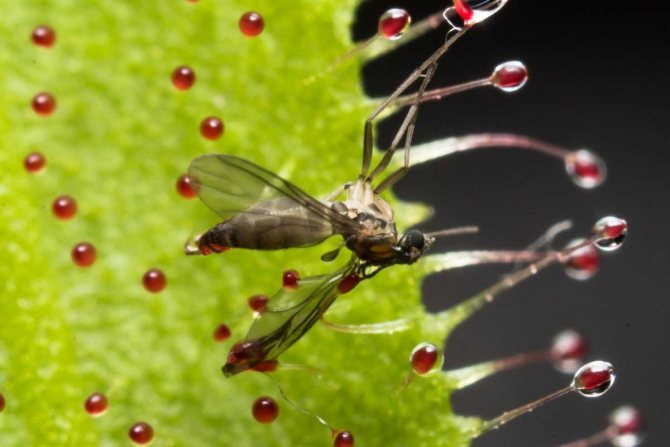

The sundew is able to keep the fly for half an hour without folding the leaves.
The nap bump is back.
At the zenith of summer, our gardens are full of dozens of different bright colors, filled with their unique fragrant aroma.However, experienced flower growers in the summer remember the time of winter cold and carefully grow dried flowers - plants that can preserve the memory of summer and decorate our homes until the next spring. Among the many such plants (miscanthus, feather grass, maned barley, statice, lunar, cmin, pampass grass, etc.), special attention deserves sowing tease or nap, nap, an uncommon biennial in our gardens of the Teasel family.
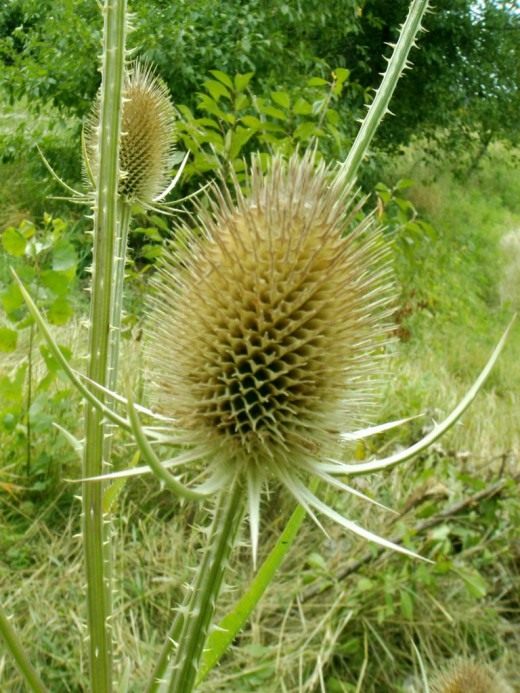

There are about 10 genera and more than 300 species in the fleece family. For teasers, the original structure of the flower is characteristic: the receptacle is usually seated with rather large scaly or filmy bracts; small and usually inconspicuous tubular flowers "run down" in a spiral from bottom to top. The wave-like flowering of these plants is very interesting: “waves” bloom from the middle of the inflorescence up and down, from the base of the inflorescence and its middle - up and from the base of the inflorescence to the top. In addition, actually sowing tease and field tease have a funny adaptation from unwanted visitors from the world of insects: their stem leaves grow together in two, forming bowl-shaped containers in which water accumulates; it is not possible to avoid such traps for the majority of crawling insects climbing up the stem.
Teasel (Dipsacus sativus) - cultural species - occupies a special place among the teasers. Its bracts are elastic, strong and elastic scales, pointed and bent downwards at the hook, while in most wild species they are straight and brittle. That is why, from ancient times, its infructescences (nap cones) were used for naping fabrics. In the manufacture of soft cotton fabrics (flannel, velvet) and especially high-quality woolen drapes, the pile knob has been indispensable for a very long time. The previous economic purpose of this plant is reflected in its other names - cordovnik, comb... This species was bred in all European countries for industrial purposes and for export, and from the second half of the 18th century. known in culture and in Russia, even later in America. However, with the beginning of the use of artificial metal cards for naping fabrics, the industrial value of nap bumps has diminished. In the USSR, teasel was cultivated in the Crimea, the Caucasus and Central Asia. The achenes of this species contain a large amount of oils (up to 30%); they were used as food for songbirds. The origin of the common tease is not exactly known, but there is an assumption that it arose in ancient times from the Mediterranean wild tease (D. ferox).
Nowadays, only the glory of a beautiful dried flower did not allow this plant to disappear from our everyday life.... Among the four types of teasers, suitable for use as dried flowers, the sowing tease is the most beautiful, and, which is very important, it has large and very strong seedlings - "cones". This plant is a favorite object of florists both as an independent home decoration and in compositions. Teasel also looks great in the garden. And even in winter, left on the site and powdered with snow, it looks very exotic.
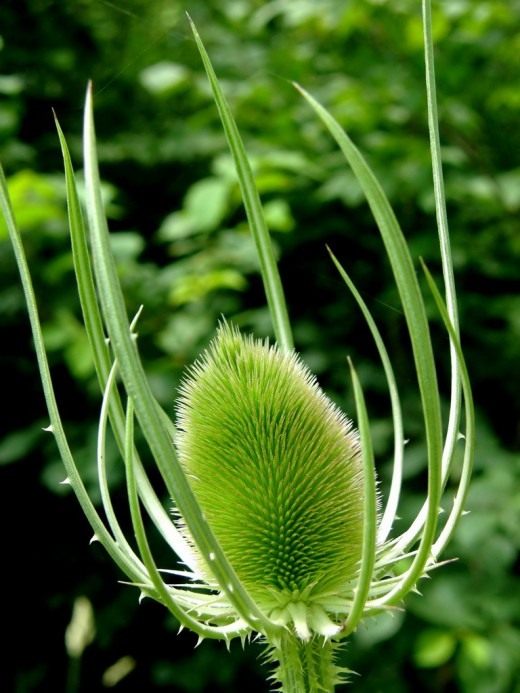

<>
Teasel sowing - large-stemmed prickly plant with a height of 1 - 2 m with opposite leaves, growing together in pairs at their bases. Basal rosettes are powerful, consist of a dozen light wrinkled leaves. The flowering stems are thorny along the entire length, branched and bear up to 20 "cones". These "cones" have a cylindrical shape, their length reaches 10 cm, they are of different sizes even on the same bush.
Cutting is usually done in early September, when the buds are ripe, but before they turn brown from the rain, they do it in dry weather.... When fully ripe, they are brown, and if cut early, they will be green (a matter of taste). In order not to injure your hands, wear thick mittens or gloves, otherwise blood cannot be avoided. Teasers have not only thorny cones, but also splinter strong peduncles. Before drying, it is advisable to remove the thorns from the stems with a sharp knife, and to remove the seeds, it is necessary to draw the knife several times from the bottom up. The cones cut off with a part of the peduncle are dried for 4 - 5 days in the shade, hanging down with the inflorescences. After that, the leaves are removed at the base and the tuft at the top, placed in a cardboard box and stored in an unheated dry room.
Although the tease is generally a very unpretentious, drought-resistant and cold-resistant plant, the most developed plants and large cones are obtained on moderately fertile loams, in a sunny place - the soil for planting should be moderately moist, loose, with a permeable structure, homogeneous in texture and not too fertile: on too fatty soils, the plant refuses to bloom (“fattens”), and too wet, low-lying lands are fraught with damping out of plants in the spring.
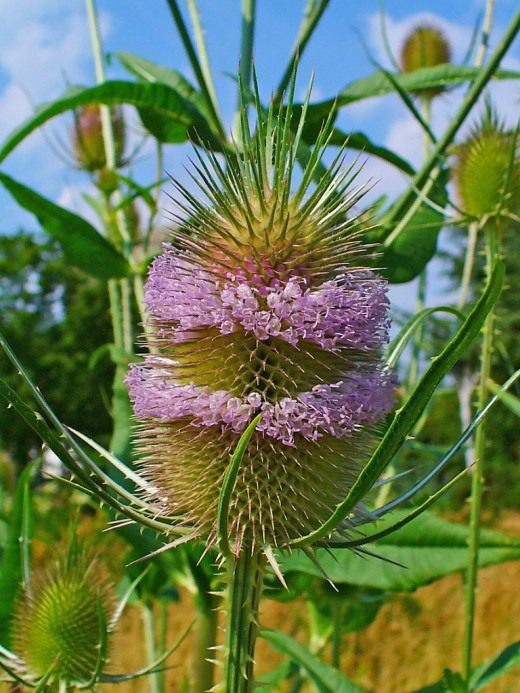

Teasel blooms in August... A month after flowering (in September), seeds ripen - tetrahedral, large, retaining their germination for a long time (3-4 years). If they are not collected in time, they fall asleep, and then the tease by self-seeding quickly conquers new territories. It can run wild and grow in nearby abandoned areas. When choosing neighbors for the tease, keep in mind that it is quite aggressive and can drown out delicate plants located nearby..
Seeds are sown to a depth of 2 - 2.5 cm in autumn, immediately after harvest, usually in early October, or early spring. It is better to sow them immediately to a permanent place.... The seeds of the tease are large, up to 5 cm in length, with a dense skin, they need to be pre-soaked for 2-3 hours in a solution of flower fertilizers or a slightly pink solution of potassium permanganate; they have a germination capacity close to 100%, therefore it is better to lay them out in the grooves one by one every 5 - 7 cm.


In the first year, only rosettes of leaves are formed, which remain overwintering.... If the rosettes grow closely, then at the end of September or in the early spring of the second year they are carefully dug up and seated - their feeding area should be at least 60 x 30 cm, otherwise the cones will be small. Plants tolerate transplanting well. In autumn, it is useful to remove several lower large green leaves in the resulting lush rosettes.; for the winter, the plants need to be slightly spud and covered with spruce branches so that they do not freeze in the snowless winter; it should be covered only with the onset of significant (-5 ... -7 deg. C) frosts, when the soil freezes to a depth of 3-5 cm; the shelter will not only save the plant from winter frosts, but also relieve it from the threat of premature (before thawing of the roots) leaf development; you should remove the cover only after you are sure that the soil has thawed completely. At the beginning of the growing season, a small amount of nitrogen fertilization can be applied.
Care consists of weeding, loosening the soil and watering.


Teasel (Dipsacus)
Teasel can suffer from powdery mildew, which appears as grayish-white spots on stems and leaves, as well as damp off the base of the stem. The fleece eel harms the tease (damaged cones dry out or voids form in them), as well as mice.
For better formation of seedlings in a flowering plant, pinch the central stem, and on the branches of the first order, all side shoots are removed, keeping only 6 - 10 cones on the bush. These techniques allow the formation of large, developed cones on long peduncles.
Teasers are beautiful enough without any processing. But they also look good after being painted. To do this, use watercolors, ink, ink, aniline and food dyes, bleaches.
On New Year's Eve, you can surprise guests by treating the nap cone with table salt.
- Pour a half-liter jar with boiling water, in which create a supersaturated solution of table salt, cool it slightly.Dip one nap cone into this solution and leave for 2 days. Salt crystals will gradually precipitate and grow on the fruit. Then take out and dry the seedlings, and you will get spectacular "snow-covered cones".


Teasel (Dipsacus)
Do not forget just before this operation to insert a strong wire into the stem so that it does not break, because the cone will become heavy. If you treat the nap in a solution of copper sulfate using the same technology, it will look strewn with emeralds.
In winter, bouquets of dried plants that do not require maintenance or watering are so delightful!
Teasel in garden design
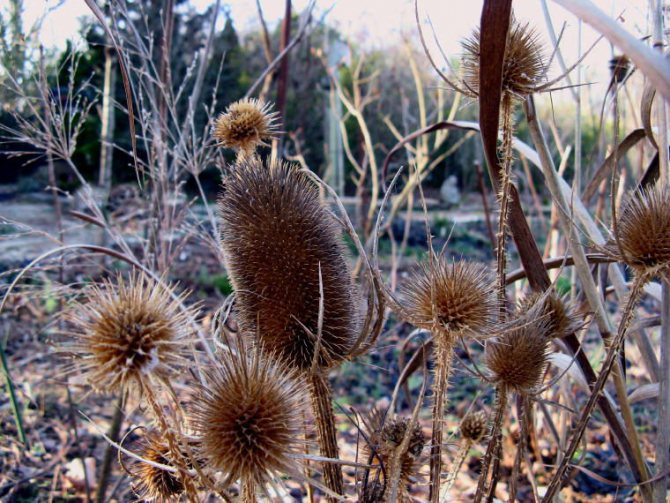

Teasel plant pile cone in landscape design photo
Against the white background of the snow-covered garden, the cones do not fall, but acquire a new color, decorating the territory even in winter. They are planted on a lawn or flowerpots so that you can easily get in for a winter photo shoot. The gardener's care for the tease will certainly bear fruit, and the buds will delight you all year round.
How to plant and grow a tease
Not right away, but you can guess that the name of the plant "pile" comes from the word "pile". However, if you do not know in advance, it is almost impossible to guess that the properties of the pile do not relate to the plant itself, but to the things that were once processed with the help of it. Much more clearly, the former functions of this herb are hinted at by its other name - the nap bump. After a protracted lull associated with the technical revolution, which almost sent the nap into retirement, now this interesting plant is back in fashion, but this time thanks to its design qualities.
Sundew plant: growth, leaves and flowering
Sundews are tiny and very neat plants that develop mostly in width. They produce compact, flat rosettes of root leaves. The root system of sundews is very weak, it does not provide the plant with food from the soil and only plays the role of keeping the bushes in the soil. With a bushes height of only up to 10 cm, the sundew can release rather long, up to 30 cm, peduncles.
The leaves of the plant are unusual, round or oval in shape, sit on rather long and thick petioles, in some species they are sessile and thin, resembling blades of grass. The size of the leaves ranges from 0.5 cm to almost 50 cm, but in indoor sundews larger than 10 cm leaves do not grow.
Long, thick, translucent reddish hairs set rather densely. The sundews release sensitive hairs with a gland at the edge, which secrete luminous, transparent, sticky droplets of mucus that glisten in the sun.
Of course, it is primarily intended for trapping insects, but the shining drops on the large, thick hairs give the plant a certain charm. The edge on the leaves of the sundew is difficult to compare with other indoor plants, because everything in this culture is special. As if covered with small drops of dew, the plant looks very decorative and attractive.
The flowering of sundews does not spoil the appearance of the plant at all. White, pink or red, flowers in spikelets and panicles of these predatory stars swing on long pedicels high above sticky rosettes and pleasantly surprise with their gracefulness.
Sundew usually bloom in spring. The double perianth emphasizes the beauty of the corolla, consisting of a pair of petals (from 4 to 8). After flowering in sundews, fruit pods are tied, hiding rather small seeds. In different sundews, pollination occurs in different ways, in indoor pollen must be transferred artificially.
Before deciding to purchase sundews, you should carefully study the features of this plant. As with any other indoor-format predator, the sundew should be accompanied by an "instruction" with a detailed description of the conditions necessary for the plant, nutritional characteristics and nuances of cultivation. You should not purchase a plant without full information about the type of plant and the specifics of care. The key information is whether a plant can grow without a florarium or a showcase.
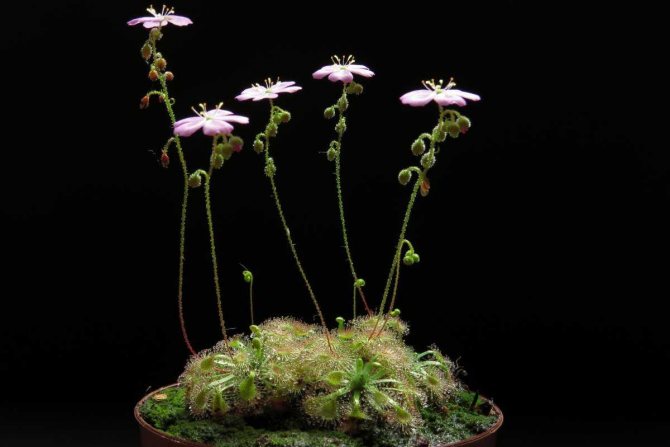

Sundew usually bloom in spring.
Useful properties and application of sundew
The marsh grass sundew is widely used in both folk and traditional official medicine. It includes:
- plumbagin - a substance that has an antibiotic effect, inhibits the growth of pathogenic bacteria and yeast;
- droserone;
- acids (citric, gallic, malic, etc.);
- calcium and potassium;
- tannins and flavonoids;
- fluoroquinols;
- tannins.
Drosera-based preparations are effective for treating:
- migraines;
- nervous system;
- tuberculosis, asthma;
- skin diseases;
- dysentery;
- colds and problems of the upper respiratory tract (pharyngitis, bronchitis, etc.);
- candidiasis;
- atherosclerosis;
- problems with the gastrointestinal tract (diarrhea, etc.);
- epilepsy;
- papillomavirus infection and chronic corns.
Antispasmodic, sedative, antipyretic, expectorant, diaphoretic, diuretic, antiseptic, anti-inflammatory properties of this extremely useful plant are noted. However, do not forget that sundew belongs to toxic and poisonous herbs, therefore, before using any remedy based on it, you should seek the advice of your doctor.
Interesting video about tease
If you liked our site tell your friends about us! Also in the wildflowers section you can read about:
- Skorostavnik - Care of skorostavnik
- Cornflowers flowers - Cornflower flower
- Yarrow - Yarrow vulgaris - Yarrow Treatment
- Mullein - Scepter mullein - Mullein flowers
- Clover - Red clover - Clover flower
- Celandine - Treatment with celandine - Celandine herb
- Chicory - Chicory Coffee - Benefits of Chicory
- Toadflax - Field plant toadflax
- Wormwood - Bitter wormwood herb
- Plantain - Flowers plantain - Herb plantain
- Mother and Stepmother - Mother and Stepmother Plant
- Chamomile officinalis - Medicinal herbs chamomile
- Flax - Growing flax - Flax seeds
- Meadowsweet - Medicinal properties of meadowsweet
- Elecampane high - Application of elecampane high
- Medicinal sweet clover - Application of medicinal sweet clover
- Valerian officinalis - The use of valerian officinalis
- Oregano - Usage of oregano - Oregano herb
- Field birch - Application of field birch
- Spring adonis - Spring adonis herb
- Belladonna ordinary - Medicinal properties of belladonna ordinary
- Buttercup - Buttercup flowers - Medicinal properties of buttercup
- Melissa - The property of lemon balm - The beneficial properties of lemon balm
- Train - Photo of a train - Grass train
- Milk Thistle (Thistle) - Application of Milk Thistle - Photo of Milk Thistle
- Common centaury - Application of the common centaury
- Three-leaf watch - Application of three-leaf watch - Plant three-leaf watch
- Marshmallow officinalis - Roots of marshmallow officinalis - Application of marshmallow officinalis
- Meadow geranium - Description of the wild flower Meadow geranium
- Dzhungar Aconite - Tincture of Dzhungar Aconite
- Amaranth spike - Wild flower amaranth spike
- Black henbane - Description of black henbane - Why is black henbane dangerous
- Dandelion medicinal - Useful properties of medicinal dandelion
- Digitalis - Photo of digitalis - Medicinal properties of digitalis
- Mylnyanka - Medicinal Mylnyanka - Mylnyanka Root
- Common cockle - Medicinal properties of common cockle
- Goldenrod - Properties of goldenrod - Herb goldenrod
- Little hawk - Photo of hawk - Reproduction of hawk
- Steel Steel - Steel Root - Steel Grass
- Scabiosa - Scabiosa species - Scabiosa flowers
- Stork - Medicinal properties of the stork - Common stork
- Mariannik - Mariannik meadow - Types of mariannik
- Chemeritsa - Types of hellebore - Application of hellebore
Chemical composition and properties
Teasel contains: flavonoids, carbohydrates, iridoids, caffeic acid and glycosides.Due to its composition, the plant has anti-inflammatory, analgesic, sweat and diuretic effects. In folk medicine and homeopathy, forest nap is used for:
- fever;
- tuberculosis and other lung diseases;
- stomach ulcer;
- oncological diseases of the stomach and skin;
- arthritis, rheumatism, gout;
- diseases of the genitourinary system;
- edema;
- syphilis;
- psoriasis, lichen, dermatosis, eczema, cracks in the skin and mucous membranes, fistulas, skin rashes, calluses, insect and snake bites.
- 1 tbsp shredded dry leaf of the forest teapot;
- 1 tbsp. boiling water.
Pour boiling water over the fluff, let it brew for two hours and strain. Take 2 tablespoons 3-4 times a day. Even rabies is treated with this infusion.
- 1 tbsp crushed dry tease root;
- 500 ml of boiling water.
Pour boiling water over the root in a thermos and let it brew for an hour. Strain. Drink half a glass 3-4 times a day 20 minutes before meals to cleanse the body. Broth:
- 50 g of forest teasel root;
- 2 liters of water.
Cover the tease root with water and cook until the liquid is halved. Strain the resulting broth, add 2 tsp. honey. Take a tablespoon in the morning on an empty stomach. The recommended course of treatment is 3 months. The broth should be stored in the refrigerator in a glass container with a lid for no longer than a month. A decoction of the roots is recommended for pulmonary tuberculosis, syphilis, and also externally for hemorrhoids.
- 1 tsp dry crushed root of the forest teapot;
- 1 tsp dry crushed flowers of the forest teapot;
- 400 ml of water.
Pour the vegetable raw materials with water, boil over low heat for 20 minutes. Then remove the broth from heat, let it brew for two hours and strain. Take 1 tablespoon 6 times a day. Also, this broth is used to prepare baths for arthritis. Arthritis tea:
- 1 tbsp dry teasel root;
- 500 ml of water.
Cover the root with water and simmer for 10 minutes over low heat. Then let the broth steep and strain. Drink 2 cups of this tea a day. Tincture:
- 10 g of crushed root or 15 g of dry crushed bark of the forest teapot;
- 100 ml of 70% alcohol.
Pour the plant materials with alcohol and let it brew for 14 days. Strain. For joint diseases, take 30 drops, diluted in 1 tablespoon of water, three times a day. Also, this tincture is used externally to treat cracks in the skin and dermatoses.
Another tincture recipe: fill a glass jar with chopped fresh tease grass halfway and fill to the top with vodka. Let it brew for two weeks in a dark place. Shake the infusion daily. Use in the same way as in the previous recipe. In case of tuberculosis, take the juice of fresh flowers and leaves of the forest teapot, 1 tablespoon 2-3 times a day. Ointment:
- 2 parts minced grass or tease root
- 10 parts butter.
Grind the plant materials and cover with warm oil. Let the product brew for two hours, and then simmer for 5-10 minutes. Strain. Use for external hemorrhoids, snakebites, calluses. For diseases of the skin and joints, use an ointment from the ash of the forest tease: take in equal parts dry roots, flowers and leaves of the forest tease and set it on fire in an iron bowl. Mix the resulting ash in equal proportions with butter and apply a thin layer to the affected areas. This ointment has anti-inflammatory properties.
Plants use fresh grass for pain relief - they grind and make lotions for sore joints. For the treatment of warts, fistulas, external hemorrhoids, poultices are prepared from the boiled root of the forest teapot.
Tease description
The plant is not safe, for protection from animals it has a thorny stem, and from insects - a special structure of the inflorescence, where water accumulates.Teasel belongs to biennial plants, begins to bloom in the second year, in the first year it gains abundant green mass, takes root.
The root system is powerful, branched, so it requires enough area for growth. The plant is aggressive towards delicate annuals, does not get along with annual dahlias, violets. Feels good in splendid isolation or with other succulents.
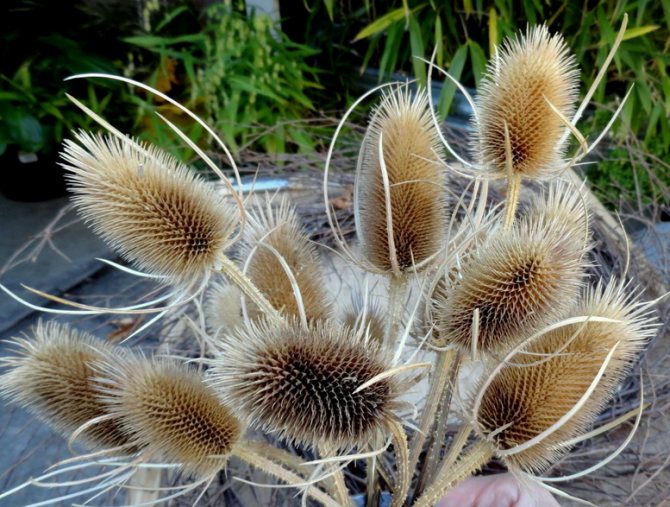

What does grass look like a tease or a nap bump photo
The rosette of leaves is collected at the base, from the center of which a long stem protrudes with a perianth at the top in the form of an oblong cone. There can be several stems, up to 10 pieces. Some varieties give 20 different-sized perianths - cones. The growth of the flower, the size of the bud, the number of peduncles, is due to the quality of the soil and its fertility.
Flowers appear by August and last until mid-September. Small, tubular, they fill the depressions of the bracts. The color range ranges from white-pink to lilac. Nature dresses up the cone with its own style: uneven opening of the petals, encircling rings. Miniature flowers go down the cone from the bottom up in a spiral. The combination of a green background and a pastel shade of colors sets the flower's playful mood.
In place of flowers, seeds are formed - large tetrahedral grains. Dry, sunny autumn weather is suitable for harvesting. If you do not remove the cones with seeds in time, then self-seeding can get offspring in unwanted places.
How to recognize sundew, plant photos
There are many species of this plant in many different forms. Its leaves can be small and round, long and wide, or generally thin, fern-like. But there will always be one feature that gave the name to this plant: the leaf will be covered with villi with drops of liquid that imitate dew. It is a food trap.
The insect, trying to quench its thirst, will sit on a leaf. However, these shiny drops are not dew, but glue with the addition of digestive enzymes and a substance called the alkaloid coniine that paralyzes the insect. While trying to get out, the prisoner will create vibrations that will feel the leaf and begin to curl up. After a few days, he will turn around again, completely digesting food. It is noteworthy that sundew leaves do not react to raindrops or debris.
Using
In addition to the fact that this plant is an excellent honey plant, for which it is especially revered by gardeners, it is also very decorative. Therefore, it is specially grown as a dried flower, which finds its place in dry bouquets, and as a noticeable element that decorates the surrounding landscape.
Check out our list of the best honey plants for your bees.
In landscape design
Amber cones that do not fall in autumn look extremely picturesque against the background of white snow in the winter garden, noticeably enlivening the landscape. They look great in winter in the same places of flower beds and lawns where they grew in summer and decorated the area with white, light yellow, purple and lilac inflorescences. Dry bouquets of teasers in garden vases on a white snowy background look very stylish.
In floristry
The cones of this plant are very much in demand among florists, who construct picturesque dry bouquets and various elegant compositions from them that adorn the interiors of living quarters and offices.
We advise you to familiarize yourself with the features of growing the best flowers for the office: monstera, zamiokulkas, violets, spathiphyllum, chlorophytum, dieffenbachia, ficus.
The natural dark amber shade of the teasers bracts is complemented by all sorts of colors that are obtained when painting the buds:
- ink;
- watercolors;
- ink;
- food coloring;
- bleaches;
- aniline dyes.
Teasers soaked in brine look very impressive during the New Year holidays, as a result of which they begin to sparkle in the festive lights with salt crystals, as if covered with snow.If you want to keep beautiful flowers in your house for a long time, choose bouquets from dry soviet: amaranth, celosia, safflower, craspedia, statice.
How to care for Rosyanka during a rest period
Rosyanka's active growth stops with the arrival of late autumn. She becomes inactive - she clearly needs peace. Move the pot to a cool place away from heaters, water less. Just make sure that there is high humidity in the room, and the earthy lump does not dry out too much. The sundew will shed some of the leaves, the rest will become less sticky - this is normal. The plant stops catching and digesting insects - it rests and gains new strength. Somewhere in the month of February, when daylight hours begin to increase again, Rosyanka awakens to life. We recommend at this time to transplant it into a new soil, looser, because the old one has clearly caked up in a year.
Botanical description
This herbaceous plant can be biennial or perennial, rising to the ground from one to two and a half meters with the help of stems covered with thorns or, depending on the species, a kind of bristle. The skin-like leaves are deeply cut and also have thorns. The flowers of the tease are small, but numerous and are colored in various shades from pale yellow to radically purple.
The flowers, grouped into cone-shaped inflorescences, are placed on long peduncles, on which they bloom in waves in rings, rising up the bud-cone and dropping down. Flexible scales of bracts, equipped with hooks at the ends, have become the main tool for which textile workers in the past used them to give hairiness to woolen fabrics.
Did you know? Without the cones of this plant, there would be no velvet, no flannel, no plush, no drape, no corduroy. Even the high-tech metal counterparts of the nap cone have not yet been able to completely replace it in the production of nap fabrics.
Sundew plant: the original carnivorous house plant
Among predatory plants, the sundew rightly claims to be the brightest and most expressive beauty. This plant attracts, first of all, with its unusual textures and play of colors. But the feeding mechanism of this swampy and quite hardy miracle is so exotic that it is very easy to forget about sundews as plants, primarily ornamental ones. The sundews require the creation of special conditions of detention, they are quite demanding on humidity, but they are easier to grow in ordinary living quarters than many more rare indoor predators. And caring for them cannot be called very difficult.


Sundew plant: the original indoor predator.
Cutting and storage
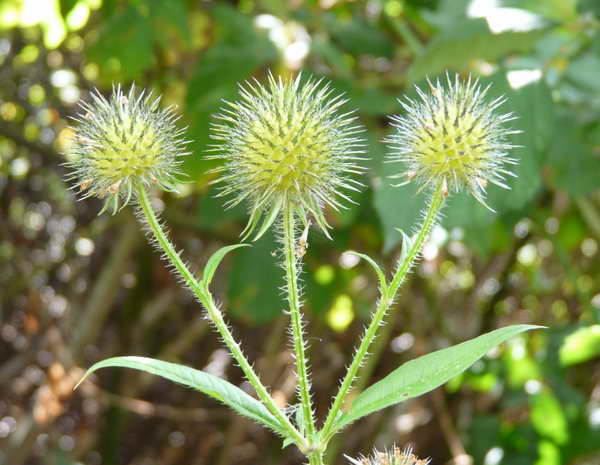

Teeth bristle Dipsacus strigosus photo
Each master needs his own special bump, therefore, when creating a blank, one should take into account the nature of the composition, its purpose. Perianths ripen in September, having clear shapes and color. If you skip the sunny harvest season, the rains will spoil the color, make it brown, dirty. Lovers of green inflorescences begin harvesting before flowering - in mid-July or early August, after waiting for the desired size.
Tools: secateurs, thick gloves to protect hands. The bush is protected by thorny strong thorns, located along the entire length of the stem and near the bracts.
Method: cut the cone at the base, leaving a small tail of the stem, hang it down for 4-5 days until it dries completely. Then clean the bract from the sepal and upper tuft.
Storage: boxes or crates with cones are left in a dark, dry, ventilated area.
Romanian and his business
|
He came to our "village" on the outskirts of Vladimir in the early 1960s from somewhere in the Carpathians, and was such a colorful figure that the whole district, having ceased to be interested in other news for a while, switched to him alone.
It all began, however, quietly and routinely.The fact that one of the solid log houses changed owners was not news of the day, in that house very few people knew the previous inhabitants. But soon the strange behavior of the new tenants aroused general interest. It began with the fact that the newcomer erected another brick shed with large swing gates to the already existing shed. This was done so quickly that it caused a lot of rumors in itself. We didn't have it that way. It was supposed to be built for several years. Moreover, all neighbors learned about the owner's intentions ahead of time. And here, yesterday there was nothing at all, and suddenly in a week - a ready-made "tower" under an iron roof. Where did this newcomer come from, in the city for a week, so quickly found out - where to buy a brick and what kind of bricklayers to hire ?!
This shed, however, turned out to be a garage, from which a vehicle unprecedented for the immediate vicinity soon rolled out - the Volga GAZ-21. In that distant 1963, this meant something more than prosperity. The people then said that one salary couldn't buy a car, and it was so.
The real name of our new neighbor was known to a narrow circle, for the majority he was Romanian. Whether he was definitely a Romanian, or maybe a Hungarian or a Slovak, will remain a mystery. It was rumored that he was born and lived in places that were abroad until 1939, and went to the USSR under the Molotov-Ribbentrop Pact.
Not knowing who a Romanian is, soon became indecent, and then completely impossible. For no one aroused such interest in himself, did not produce so many conjectures about himself. A man of about forty, short, lean build, broad-shouldered, he was outwardly unremarkable. There was, however, in his speech a slight accent that could be mistaken for a southern dialect. His friendliness and smile were somehow non-Nashen. They also said that he knows how to brew beer. One of his neighbors even earned the right to be his constant drinking companion. But this neighbor was not unusually chatty, and if he told something about Romania, it was so respectful that he only added fuel to the fire.
Hard-working and enterprising, the Romanian fully possessed what was later considered an entrepreneurial streak. But then it looked like ordinary adventurism. From the current position, it seems that he simply was not afraid of Stalin, did not know what a collective farm and the elimination of the kulaks as a class were. There was in his character decisiveness and consistency that were completely uncharacteristic of local peasants. While apple trees were growing in all "normal" gardens, he, without any torment, in the very first weeks after the housewarming, organized such a pogrom that by this alone he awakened unprecedented unrest in the public consciousness.
To cut down all the apple trees in early August, and together with the ripening fruits, carry these "firewood" into the nearby ravine !! There, without fiddling around, he took out on a cart old boards and the darkness of all "valuable" junk, which the natives instantly took home. The people whispered in fascination, exchanged glances, looking at such an absurd behavior of the new settler, watching what would happen next. And then it was autumn, and Romanian's garden was completely covered with even standard ridges. In the spring, when the time for germination came, the area was covered in tulips. Everything fell into place.
|
The fact that the Romanian was growing and selling cut flowers “in extra large sizes” was in itself extraordinary courage. But we, local boys, were most outraged by his wrong attitude to the car. He did not go fishing or to the beach, and he did not even "bomb" with a cab. While all car owners dressed up their carriages, he treated the car worse than a drayman did to his cart. As I remember now, this behavior seemed outrageous to me. Now I would justify Romanian with only one argument - "labor makes free." But then, I was 11 years old, and my concept of freedom was primitive. I brushed aside the "realized necessity" as an inedible surrogate.If I had my own "Volga", then I would have thrown school and boring textbooks on the figs, I would have bought a camping tent, spinning rod, a gun, and would have lived a free life, moving from place to place!
But the Romanian did not understand anything about real freedom. His car practically did not know other passengers than himself and his wife. Filled with tulips and gladioli to the eyeballs, she scurried about the markets, so that soon Romanian was recognized in almost all regional centers from Vladimir to Moscow.
But he didn't stop there. Soon he began to disappear from time to time somewhere, and after that he and his wife secretly unloaded the car in the evening. Only the ubiquitous boys saw how they dragged into their spacious shed and hung bunches of some thorns on the shelves. They dropped one of them, and for a long time we twirled an incomprehensible dried plant in our hands - something like a huge turnip on a stick.
It was a nap or nap - a plant that is an excellent dried flower. Gradually, naping became the main direction of Romanian business. At the door of the barn one could see that there were many thousands of thorny fruit. It was impossible to sell such a quantity with us, because it was in good demand only on Easter and memorial days.
That memorable era of widespread scarcity for enterprising people was paradise. The outlandish plant found its buyer. In local cemeteries, in almost every flower girl, a dry flower, well preserved all summer, of carmine color, stuck out. On the eve of the bad days, Romanians were spinning a squirrel in a wheel, delivering goods to their dealers in other cities. Easter for him and his wife was like New Year's Eve for the champagne sellers. There were two cemeteries in the city, and in both there was a brisk trade in dried flowers.
His other half was especially dexterous in this matter, he gave her the most lively place. The envious neighbors claimed that the people went to her as to the Mausoleum. Three assistants helped her to manage, they served flowers, but only the hostess accepted the money. I myself once saw her doing this work. Her hands fluttered like the hands of a weaver-weaver - not a single superfluous movement, not a single empty word. Today's tradesmen would simply go crazy from this sight.
ABOUT! It was a poem! The apotheosis of a monetary symphony, a virtuoso scherzo for state bank tickets, Appassionata on treshnitsa and chervonets !! With non-vain and precise movements, in which both hands participated in milking a cow, she forwarded the banknotes to a special cloth bag attached somewhere below the abdomen. Being an empty pillowcase in the morning, by the end of the day this "wallet" became a whipped thought. How many there were, we could only guess, but as if it was not at all the pennies for which the highly paid Soviet miners worked hard.
I will note that my fellow countrymen loved to count other people's money - do not feed them with bread. A year later, there was a steady rumor about Romania as a real Soviet millionaire. You can judge for yourself what a million rubles meant in 1964 - a good house in the city was sold for 5,000 rubles that year. But who would say, looking at him, that a thousand Khrushchev's "new" rubles is not money for him. He dressed modestly, even unprepossessing - if you met on clothes, there was nothing to look at. The people, however, "were aware" of all his financial affairs and promoted him "in black". He himself did not participate in conversations about his welfare. “Money loves silence”, “do not wake up dashingly while it’s quiet” - these rules Romanians strictly adhered to. However, there were no such threats to his business. The word racketeering was then absent in the dictionary, although there was another - OBKHSS. But even here, apparently, everything was sewn and covered, in any case, the tax agent, they say, came to see him.
Now, when every more or less rich merchant dresses to pieces and boasts of a jeep bought on credit, I see a Romanian as almost a Franciscan monk who has taken a vow of begging.He, no doubt, had more to his soul, but did not show any claims to luxury. Except for the car, and for the Romanian she was only a means of transportation, then he was no different from his neighbors. His house was outwardly modest - an ordinary hut. His only weakness was his daughters, who were almost my age. But even here the sense of proportion did not fail him. And as for their blue trousers with the "Levis" patch, then by God, all the neighbors perceived them as workwear.
As the Romanian appeared, he disappeared - he departed in an unknown direction. They claimed that he bought another house, either on the outskirts of the capital, or in it. Surrender, he is now found somewhere there. I wouldn't be surprised if his last name is on the Forbes list, well, at least in the second thousand. I would be sincerely glad for my fellow countryman, because I consider his method of enrichment the most worthy. After all, not a single guest worker, except for his wife and daughters, was seen on his site. God knows he did not harm socialist property either. The daughters, by the way, had more than adequate remuneration for their efforts. In any case, they did not know for sure that they would refuse their simple, by today's standards, whims.
After his departure, several people continued to cultivate the pile. But where were they, the pitiful apologists, before him! Inspired by the genius of the market economy, they had neither his mind nor his grasp. Therefore, their business did not flourish, but only glowed. Not flaring up, it soon faded away quietly.
Benefit and harm
Processed sundew leaves are used in folk methods. With the help of them they get rid from warts, papillomas, small scars.
Infused flower juice is used as diuretic and diaphoretic... Many extreme people bury sundew tincture in their eyes and drink for fevers. Is an antibacterial agent.
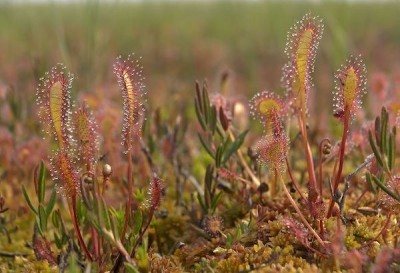

The composition includes malic, benzoic and citric acid... The plant is rich in vitamin C.
The flower contains calcium, tannins and potassium salts. It also contains droserone and plumbagin. Also, the Italian liqueur "Rosolio" is made from the sundew.
Types of tease with description and photo
The most popular among gardeners and florists are 2 types: sowing and field tease. In total, breeders have bred about 300 species, collected in 10 genera. With the development of floristry, there was a need for new types and forms of dried flowers. Breeding enterprises develop new varieties that are resistant to diseases and weather conditions, with high decorative value.
Teasel sowing Dipsacus sativus
It is a cultivated plant, the purpose of which was originally industrial in nature. It was grown as a device for naping fabrics. Europe supplied teasers all over the world. At the end of the 18th century, it was brought to Russia by traders. Before the advent of metal devices and automated production, the cone was used to make fleecy cotton and woolen fabrics (flannel, drape).
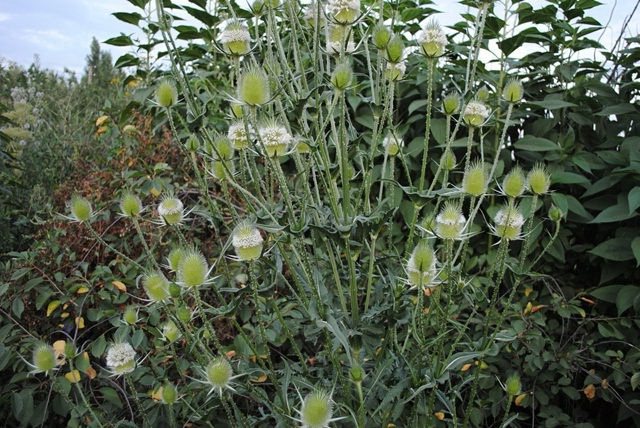

Teasel sowing, nap cone, white Dipsacus sativus
The species is unpretentious, but loves a warm and humid climate. The Crimean Peninsula, Caucasus, Central Asia became the optimal place for cultivation. The bract, forming a bump, is large, and the scales are elastic, strong, pointed downwards. Unlike the wild-growing species, it differs in plasticity, does not break with intensive use. It reaches a height of 1-2 meters, thanks to high strong pedicels, it holds well, does not deform after rain and wind. In total, a bush can have up to 20 cone-shaped cones measuring 10 cm. On one plant you can find small and large cones that are perfect for decorative arts.
The seeds are large and fill the entire bump. The seed has a fatty acid content of up to 30%, making them great for songbirds. This is another use of the plant.Bird watchers have noticed that the sound of the voice, the general well-being of the bird improves after the tease. So they began to breed the flower as food for birds.
Giving a wonderful perianth-cone, the sowing tease has become a favorite of florists and interior designers. It is used to decorate a room both in its natural form and with the use of coloring and decorative elements.
Teasel forest or field Dipsacus Fullonum = dipsacus sylvestris
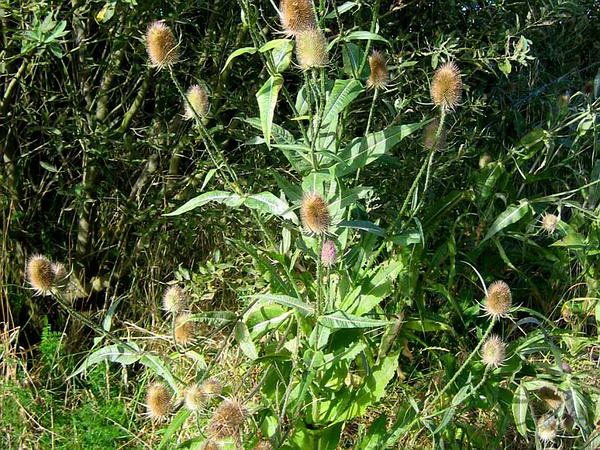

Teasel forest photo Dipsacus Fullonum
A wild plant that occurs naturally on the slopes of reservoirs in the European part of Russia, the Caucasus, Asia. The popular name "brush" received for its bract - a bump. In contrast to the cultivated species, the field fleece has a relatively smaller size, simplicity of appearance. It blooms in July and early August with purple, white or pink flowers. The chaotic spread of seeds and uncontrolled growth can create impenetrable thickets of teasers, which prevent animals from drinking.
Wild fluff is used to prepare medicinal mixtures and decoctions that have analgesic, anti-inflammatory, antispasmodic properties. One-year roots, leaves, perianths are suitable for cooking. Sometimes cones are used as a means of saturating the body with polyunsaturated acids (suitable for dietary nutrition).
Using the tease
The plant has received recognition from both designers and home healers. Its application is multifaceted. Use the entire plant as a whole, including roots, leaves and bracts. Design:
- drawing up one-component and prefabricated bouquets (you will need cones on the peduncle);
- bouquet baskets and gift boxes (green young cones are needed);
- a panel of dried flowers (ripe bracts without flowers or with flowers);
- interior decoration, festive compositions, decorative highlights (cones of different sizes).
Ethnoscience:
Anti-inflammatory and diuretic decoctions for colds or ulcers of the gastrointestinal tract, edema, metabolic disorders. Preparation of the broth: 1 tsp each. Pour 400 ml of water over the crushed roots and leaves of the tease, boil for 20 minutes, leave for about an hour. Take 1 tbsp. 6 times a day before meals. The juice has antioxidant properties.
- Relieves inflammation, removes redness after bruises, boils.
- Prevents rashes, relieves itching after insect bites.
- It is used as a pain reliever for rheumatism and gout.
Preparation of the ointment: mix tease ash (burn the dried whole plant, grind it into powder) with butter 82.5% (you can homemade). Store in refrigerator for up to 3 months.
When the sundew blooms
In most varieties, the flowering period occurs in late spring and summer, it lasts about 2-3 months. The plant produces from the middle of the leaf rosette an elongated thin stem with an inflorescence-spike, composed of several small buds of deep pink, lilac, beige or whitish color. Each flower, which has a double perianth, has 4 to 8 petals, the diameter varies from 15 to 40-50 mm.
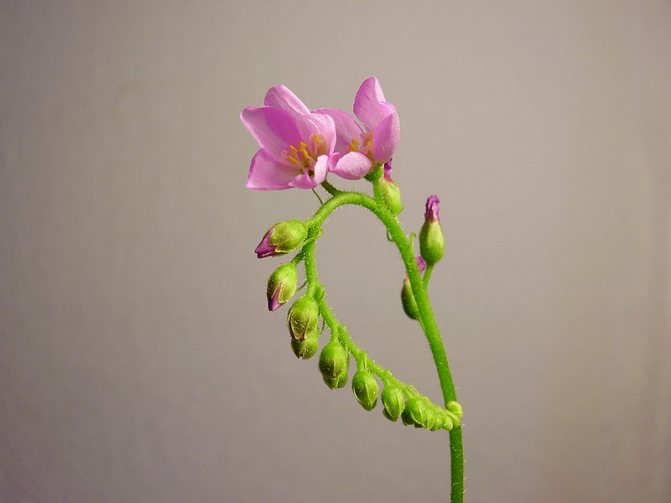

Plant subspecies
At the moment, we know a little more 150 subspecies of this predatory flower. The most famous subspecies:
- Round-leaved - grows in marshes of the temperate zone. Latin name: Drosera rotundifolia. Leaves are oval, growing on elongated petioles. They reach no more than 2 cm in diameter. They look like miniature plates. The upper part of the leaves has villi.
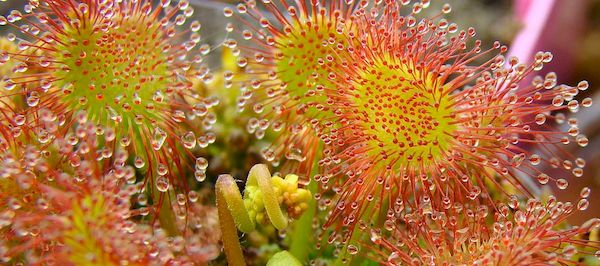

- Cape - the most beautiful of all subspecies. Latin name: Drosera capensis. Endowed with very short branches. The leaves are graceful, thin. Grow on elongated petioles. The color of the leaves is emerald-amber or burgundy-brown. The cilia of the plant are claret. After the insect enters the trap, the leaves of the plant are rolled into a small roll. The plant is endowed with beautiful flowers.
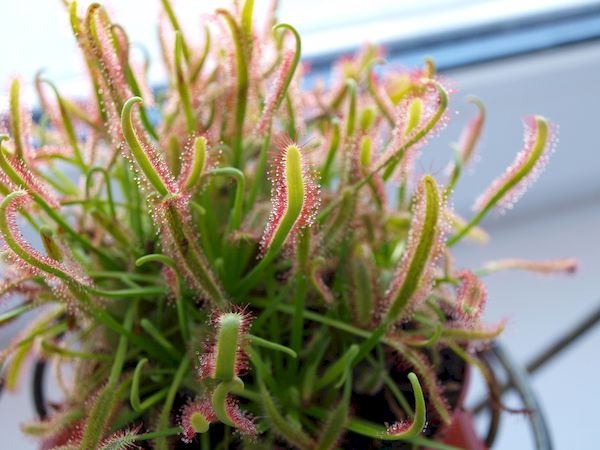

- Intermediate - the rarest subspecies.


- Long-leaved - has narrow, elongated leaves. Grows in swamps and overgrown rivers. It is sometimes called "English".
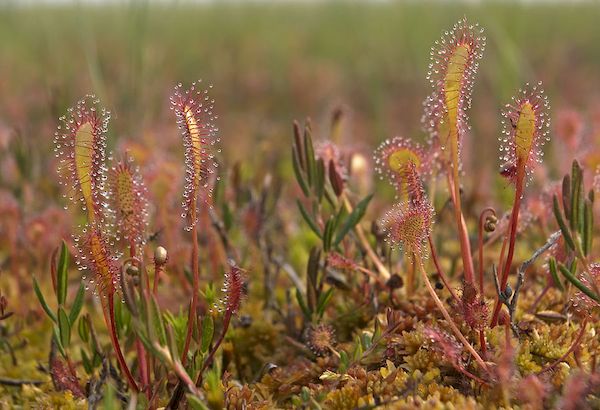

Read more about the varieties of carnivorous plants in our article.
Acanthus: description
Acanthus is a plant from the genus of the same name, which includes about 40 varieties, herbaceous and sometimes shrubby plants. Large leaves of the plant are collected in a rosette, pinnate, with thorns along the edges. Acanthus blooms with spike-shaped inflorescences, the flowers are white, blue or red, the bracts are large, very often with thorns. The distribution area of the tropical and subtropical belts of Africa, Asia and the Mediterranean.
Another flower from Africa is Gatsania.
To learn more
The name is given to the plant Akanthus from the Greek acantha - literally translated - thorn. It was received for the fact that the leaves of the plant are mostly with thorns.
In 19th century medicine, Acanthus was called the bear's paw. Now this name refers to another species of umbrella plants.
